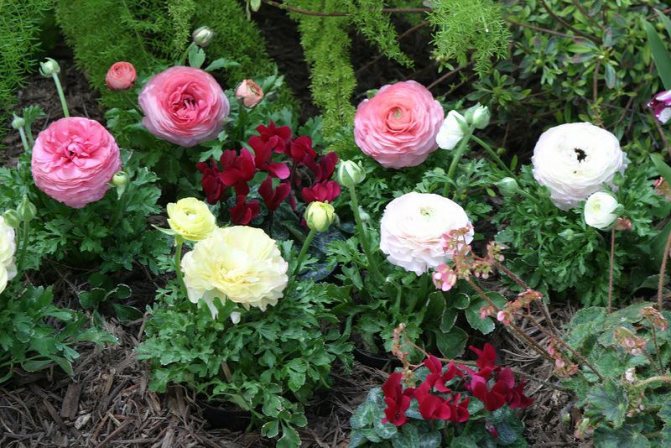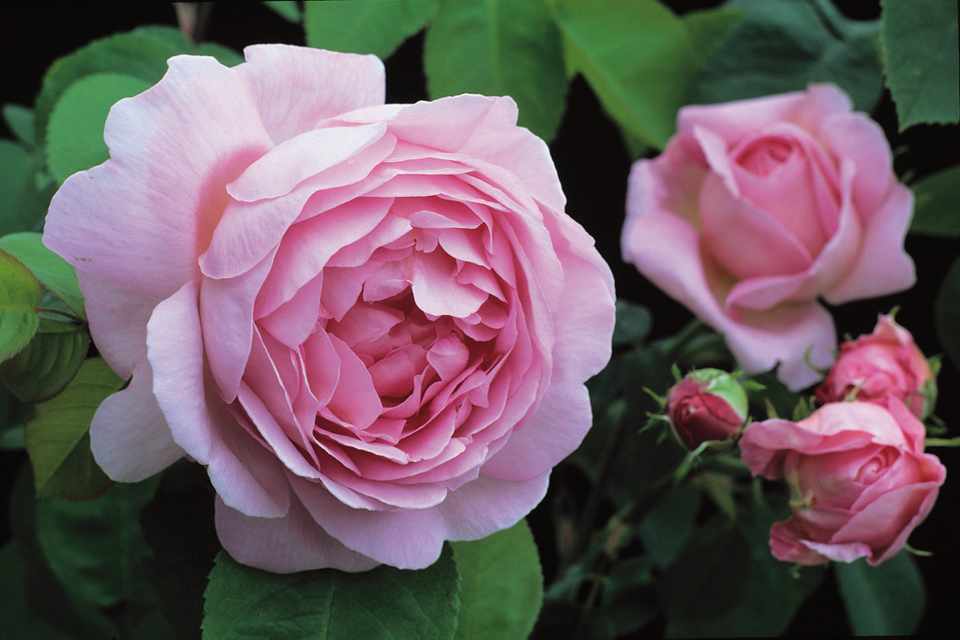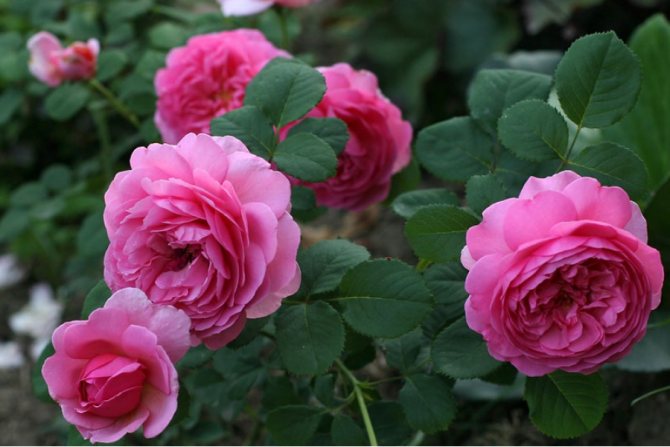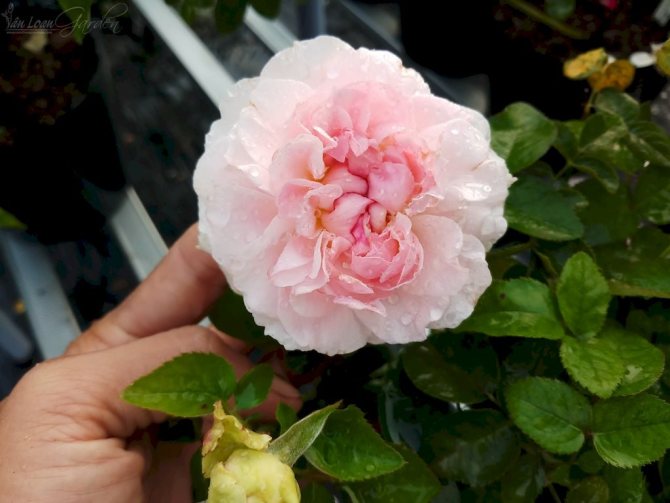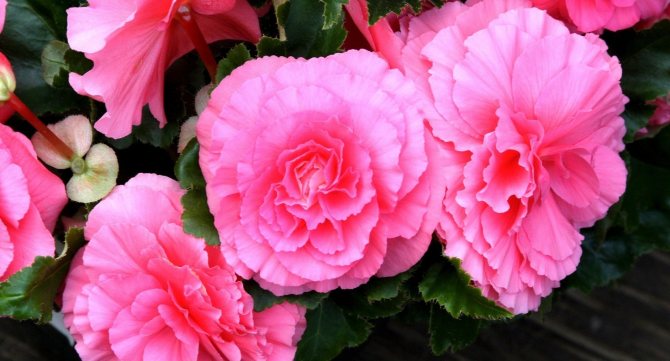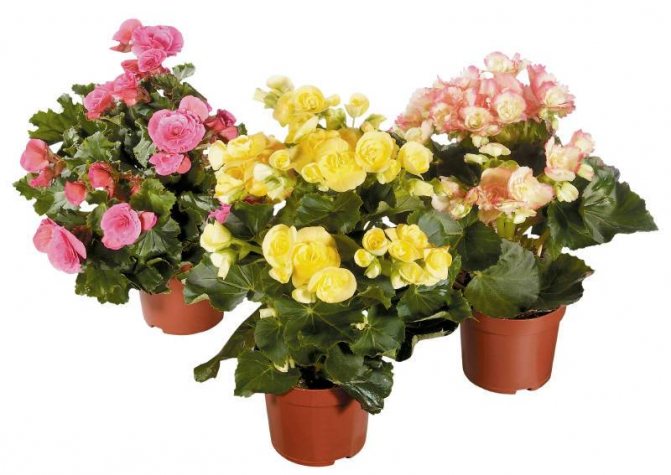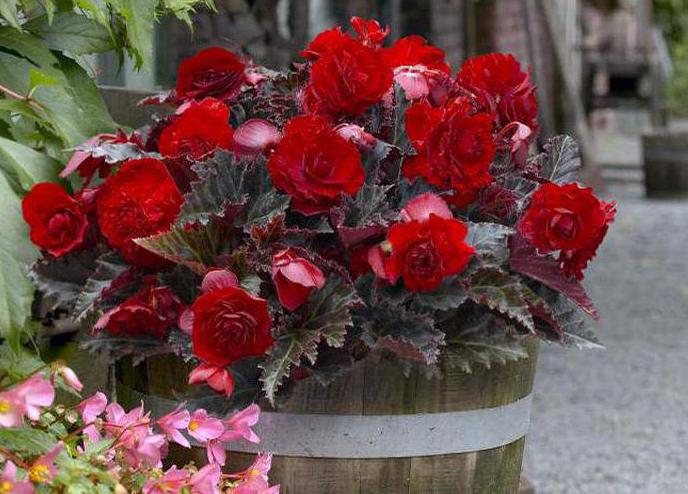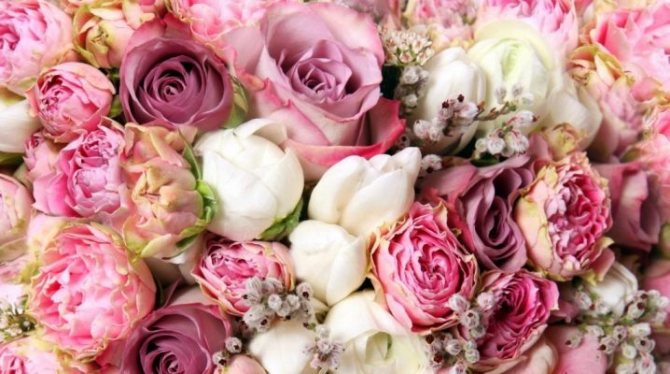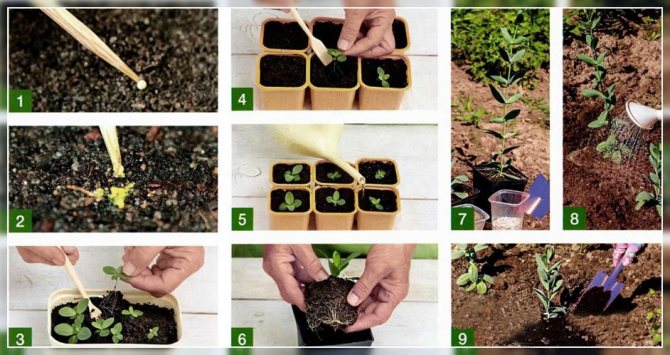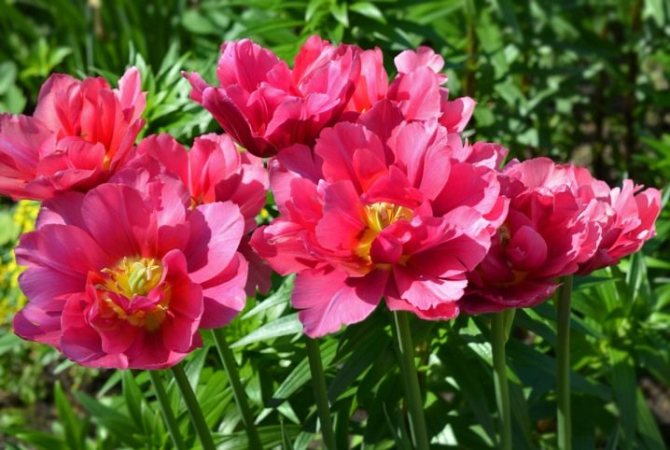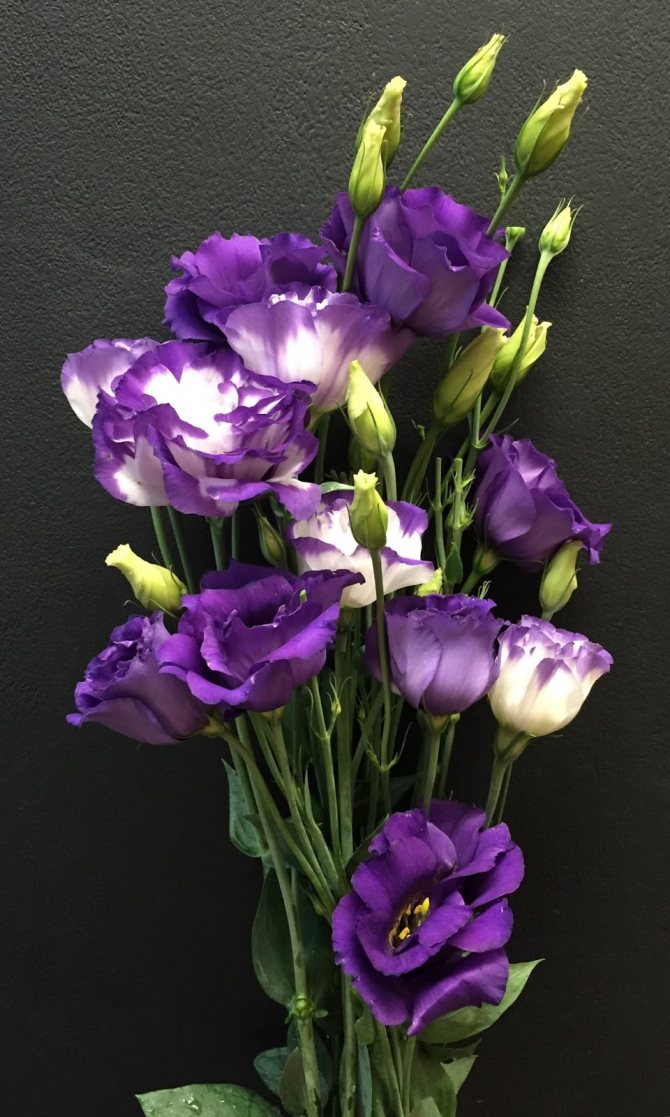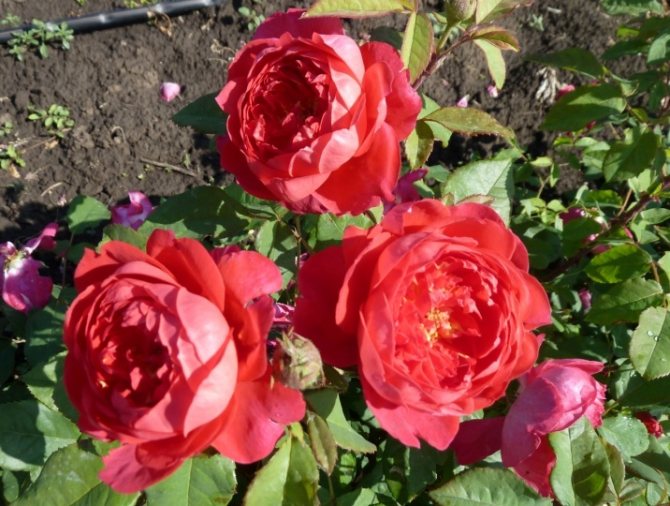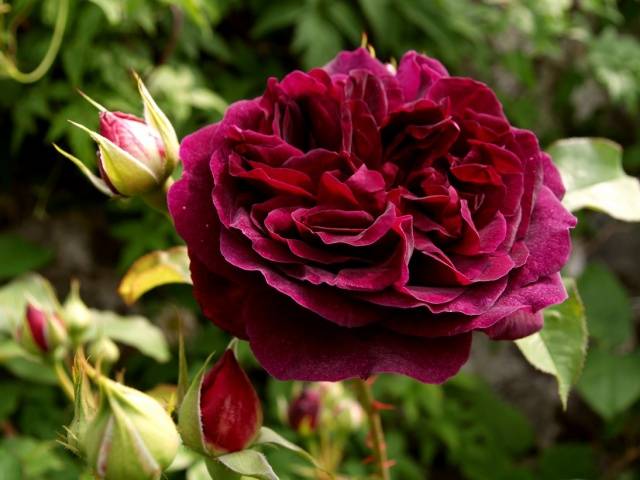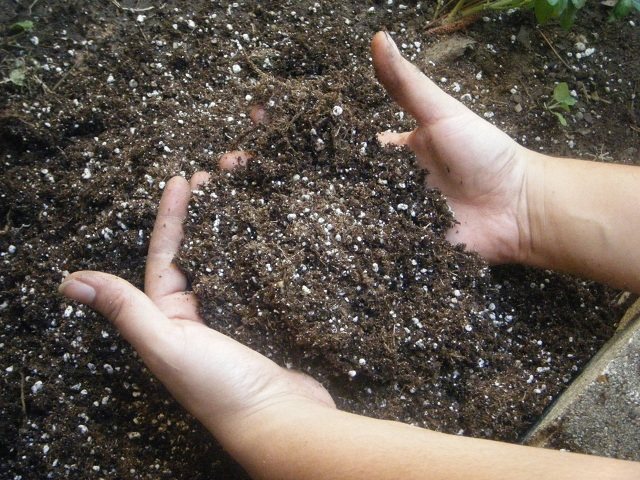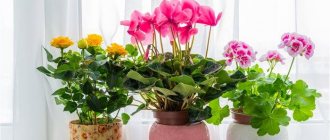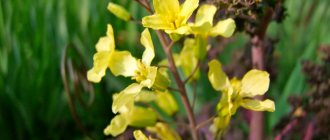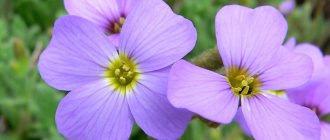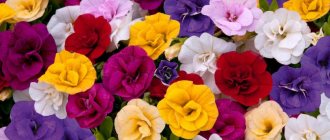Roses are wondrous royal flowers for all time. There are rare flowers that look like roses, they are also beautiful and adorable. When you see them, an association with a rose immediately arises, but, of course, there are differences, there are no thorns - protection and a symbol belonging to only one queen - the rose.
Similar flowers are very similar to the rose and are attractive to gardeners: peonies, Kalanchoe, gardenia, primrose, ranunculus, geranium, terry balsam, adenium, begonia, eustoma. They do not have thorns and in their own way they are all beautiful and adorable.
Eustoma
Another name for eustoma is Lisianthus Russell. This plant can grow from 12 to 150 cm in height, depending on its belonging to a particular variety. The number of eustoma flowers can vary up to 20 pieces. Flowering occurs magnificently due to the gradual blooming of flowers and the large diameter of the buds - from 5 to 15 cm ... Petals come in two varieties: double and non-double. The Lisianthus should be protected from direct sunlight as this can harm it. The optimum temperature for growth is 22 degrees. Vegetative propagation is impossible due to the fragility of the roots and the lack of shoots.
Delicate ranunculus
Ranunculus is a flower that is considered a wedding flower in many countries. Its progenitor is an ordinary buttercup. Delicate buds, in blooming, resembling roses, can become an adornment for any bride.
The flowers are endowed with varying degrees of doubleness, depending on the species. Most of all similar to roses (which is clearly visible in the photo) Asian and Persian ranunculus.
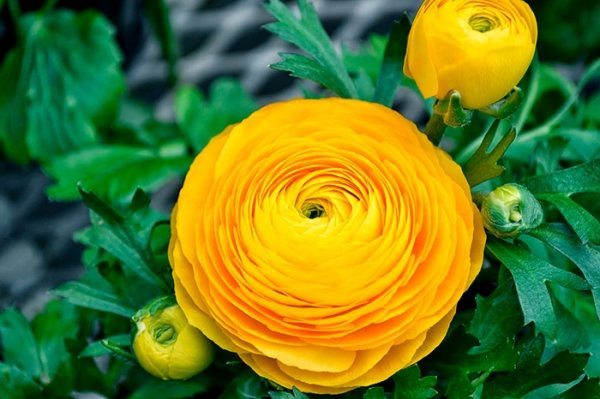
Ranunculus
The rhizome of the beautiful plant is tuberous. The stem branches strongly with growth. Several flowers bloom on one shoot, covered with carved leaves. When cut, they do not fade for a long time. The color is varied: from pure white to dark red. In the open field, these "roses" bloom all summer. When grown in pots, it is much longer.
Attention! Ranunculus should be handled carefully. The sap of the plant contains toxic substances.
Grow a buttercup in one place, since the death of a flower is possible during transplantation.
- Prepare a hole with a drainage layer and fill it with breathable soil.
- At a depth of 8-10 cm, "fingers" down, arrange the rhizome.
- Sprinkle with soil.
- If a cold snap is expected in the near future, the planting should be covered with polyethylene or agrofiber.
For the winter, the tubers are removed from the soil and sent to storage in sawdust or sand at a temperature not exceeding +5 ° C.
Ranunculus
Another name for Ranunculus is garden buttercup. It is a dwarf, up to 50 cm, perennial garden plant with about 600 varieties.... The most popular among flower growers are the Persian and African varieties of Ranunculus. With regard to different varieties, the shape of the bud of the garden buttercup repeats the shape of the outlines of roses, peonies and poppies. Prefers light or partial shade. Feels comfortable in loose, moderately moist soil. Reproduction is carried out through seeds or by transplanting root tubers.
Hellebore flowers
Not a rose, but very much like it. The advantages of the hellebore can be judged by the name, in other words, if the climate is too cold, the hellebore is ideal for growing.This culture is a perennial, it is evergreen and rather large - about 30 cm in height, and it can be planted both at home and in the garden.
Attention should be paid to the size of the pot, the roots of the hellebore are longer than itself, so the container should be quite large. If you plan to plant at home, you need to choose a cool and shaded place. Direct sunlight should not fall on the plant, as well as excess electric light.
And if you want to place a hellebore in the garden, then the soil must be selected clay and not planted near other flowers. One minus, already encountered among flowers that look like a rose, is a poison that can have a very detrimental effect on the health of a person or an animal, so the main warning is that if there are children or animals in the house, then it is better to skip this option.
Hellebore
The hellebore or otherwise Gelleborus is a perennial plant that, in addition to its attractive appearance, also has medicinal properties. There are about 15 species of hellebore, but the most popular of them are Hybrid hellebore and Caucasian hellebore... The height of the plant relative to the variety is in the range from 40 to 70 cm. Abundant flowering: several flowers can be located on one stem. Flowers are varied in shape, up to 8 cm in diameter. The shade is usually white-green or yellowish. Loves partial shade, feels comfortable among bushes and trees.
Description of the plant
Irish rose eustoma is a perennial plant. Most growers use it as an annual. Due to its unusual appearance, it has attracted the attention of many florists who use the plant to create unusual compositions.
Rose renaissance
Many species of lisianthus have been created. A flower that looks like a rose eustoma can be found quite often. So, for example, among them is the Scottish rose. Each of them is good in its own way and requires different care. Basically, the culture is not demanding to care for.
The small-sized flowers of perennial eustoma look like rosebuds that have not yet opened. They reach only 5 cm in diameter. The color scheme is varied: both monochromatic flowers and two-colored. The bicolor buds are especially mysterious. The texture is usually smooth and velvety terry. The petals look thin and delicate like silk. They have a stone shade. The stem of the Irish rose is graceful and slender. Despite this, it can withstand many flowers located on it. Most often, the flowers bloom in a specific sequence, one after the other. Sometimes they can open together, as one full-fledged bouquet. The leaves of the Irish rose are oval in shape. They have a blue-green waxy coating. In the creation of new types of Irish rose, breeders have gone far. They easily bring out more and more new samples, the height of which reaches a meter. The exception to the rule is varieties of domestic plants. Their height is about 30 cm. Some flowers have an amazing aroma.
Note: there is an Icelandic rose - this is a variety of Saintpaulias, proposed by foreign breeders. It has nothing to do with the pink family.
Chinese rose
The Chinese rose, despite the name, does not belong to the same genus with roses. It belongs to the genus Hibiscus and has an alternative name for Chinese hibiscus. It is so called because of the similarity of the growth area. Has successfully spread all over the world. It is a shrub up to 3 m high ... The flowers are originally red shades with a diameter of up to 16 cm. As a result of selection, varieties of other shades and bud sizes were obtained. Loves a hot, humid climate, prefers a sufficient amount of sunlight. In general, it is unpretentious.
Plant care
After planting the plants in pots, they should be properly cared for. First of all, a sufficient amount of sunlight, you can also use artificial.The room must be ventilated, without drafts. Watering is carried out only with soft, settled water. In watering, it is required to observe the measure: to prevent drying out and waterlogging of the soil. If the soil is too wet, the root can start to rot and the plant will die. No need to spray. During flowering, fertilizer must be applied in a timely manner.
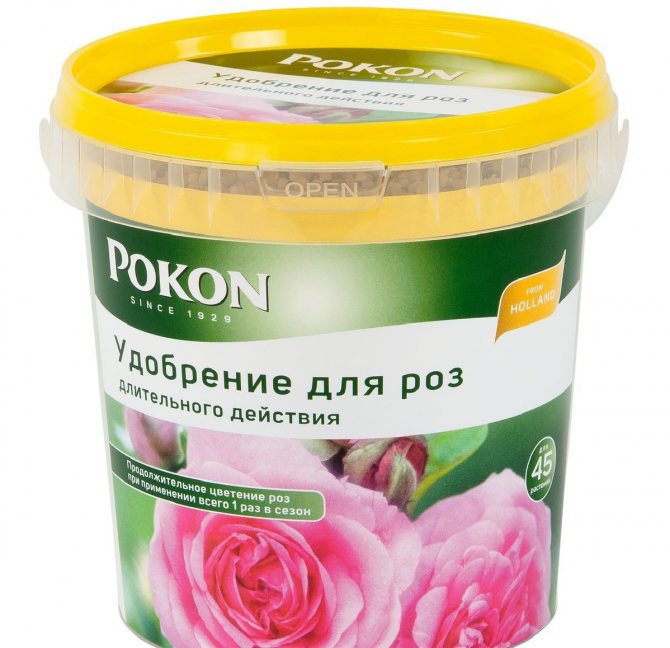

Fertilizer for roses
After flowering
Indoor rose should be cut after flowering, leaving two or three internodes. In this state, the plant requires rest. Indoor temperature +15 degrees. Watering is required minimal, no fertilization is needed. When shoots appear, transplant into a new land.
When the garden eustoma has faded, it can be transplanted into a pot by placing it on the balcony or in the apartment. He also needs a rest period. Caring for a garden plant at home is the same as for a room one.
Begonia
The birthplace of begonias is the tropics and subtropics, so the plant is warm, light and moisture-loving. There are about 1000 species with distinctive features of the shapes and shades of flowers and leaves. In view of such a variety of begonias, they are divided into three groups: shrub, semi-shrub and herbaceous... Florists prefer herbaceous hybrid varieties, since caring for them is the least demanding. The most popular are flowering begonias, which shed their foliage during flowering, and leaf begonias, which retain foliage, but do not bloom as expressively. Reproduction is possible using seeds, cuttings or tubers.
Tuberous begonia
This flower is more popular among gardeners, who annually decorate their site with new varieties of begonias, by the way, there are more than a hundred of them. They also differ in unpretentiousness and constant flowering, this is an important factor in garden plots. As for color, there is also a whole abundance here: cream, burgundy, pink and white shades. The buds look no less beautiful than roses, because they also bloom and have an interesting petal shape. What rules you need to know about begonia care:
- landing should be carried out only in open ground;
- a flowerpot is also suitable, but it should be large and it is better to put it on the street;
- planting this "rose" is necessary only in the warm season;
- as for the winter period, you can delight yourself with the sight of blooming begonia at home, since it is better to keep it warm in the cold.
Terry Adenium
Terry adenium was nicknamed the desert rose because of the shape and bright scarlet color of the flowers. The plant is a short, up to 50 cm, tree with rounded leaves... The homeland of adenium is Africa, so it needs a lot of light and warmth. Does not like shade, feels comfortable under the sun's rays. The average comfortable temperature for him is +25 degrees. The bud consists of three or two rows of petals, which is a striking feature of the terry aleniums. Flower size up to 8 cm in diameter. Adenium juice is poisonous, so you need to be as careful with it as possible.
Garden plants that look like roses
Many growers, seeing unusual medium to small-sized buds on the lawn, wonder what the flowers that look like roses are called. Some are surprised by the variety of colors, ranging from pale pink and bluish purple to orange, bluish hue.
Others wonder why bush roses are so small, or, conversely, not too double. The fact is that there are quite a few varieties of plants, and they all bear some resemblance to the queen of the garden - the rose.
The most popular among gardeners are the following names for horticultural crops:
- eustoma;
- ranunculus;
- hellebore;
- terry adenium.
Consider how these plants are similar to bush or miniature roses, we will study their external differences.
Eustoma (Lisianthus Russell)
Eustoma is known to experienced plant growers under a more difficult-to-pronounce name - Lisianthus Russell. Popularly referred to as the Japanese or Irish rose.This low ornamental plant grows in a flower bed up to 140 cm, but it can also be miniature. The height of some varieties is only 15-30 cm. Up to 20 flowers similar to roses can bloom on one bush. Lush flowering is possible due to the sequential opening of the buds and their doubleness. There are also non-double varieties on sale.
The most common colors of eustoma are blue and purple, but thanks to the work of breeders, varieties have appeared with pinkish-white, peach and even bright red buds, exuding a delicate aroma. A flower, unlike a rose, does not propagate vegetatively, since it has no shoots. On sale there are usually hybrid varieties - Echo, Magic ("Magic"), "Twinkie", "Cinderella", Matador, "Sapphire".
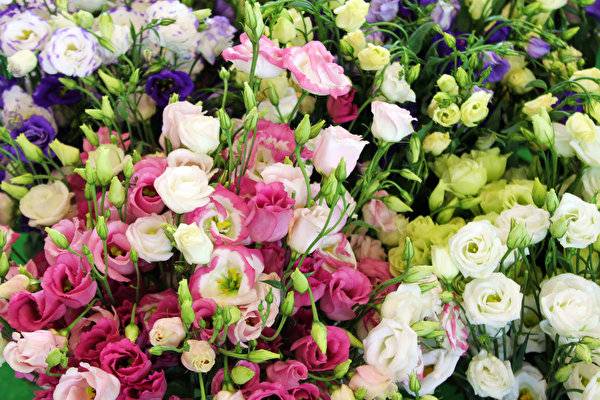

Ranunculus (garden buttercup)
Ranunculus is an unusually spectacular garden flower, often called a buttercup. It grows up to 40 cm and is a perennial plant. In total, there are about 600 different varieties, the most famous among gardeners are the African and Persian buttercup.
The appearance of the bud at ranunculus strongly resembles a rose, only small and very neat. The flower is similar to a peony. Buttercup grows usually in partial shade, propagates by tubers and seeds. The main colors of the petals are white, pinkish red, crimson, yellow and light orange. The diameter of a fully opened bud usually does not exceed 5-6 cm.
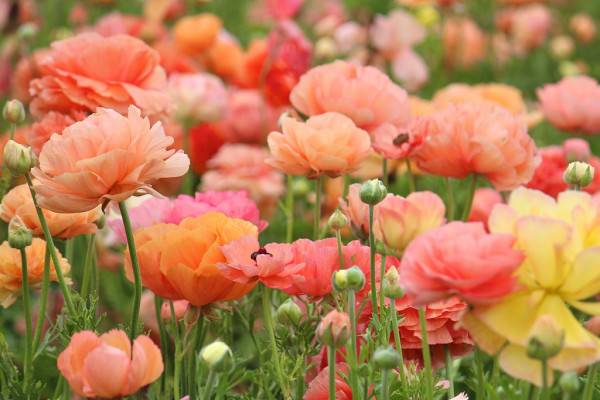

Hellebore (Gelleborus)
The hellebore is not only beautiful in appearance, but also a medicinal plant, divided into 15 subspecies. The most popular are such perennial varieties as hybrid gelleborus, black and Caucasian. The flower often reaches a height of 40-50 cm with proper care. The hellebore, unlike garden roses, loves partial shade, prefers to grow under bushes and near tree trunks, and propagates by seeds.
The flowers of a beautiful plant are varied in shape, reaching 7-8 cm in diameter. The main colors are white, with yellow and light green tints. Helleborus is not afraid of frosts, it is considered poisonous.


Terry adenium (desert rose)
Terry adenium is a very unusual flower, colloquially called the desert rose or the Star of Sabinia. It is a woody succulent about 30 cm high and is considered highly poisonous. Its gorgeous flowers resemble shrub roses, painted in all shades of white, red and their variegated combination. The leaves are rounded, olive-colored.
Terry adenium blooms from early spring to mid-autumn, grows up to 30-40 cm in indoor and outdoor conditions. But in its homeland, in South Africa, the flower reaches 10 m, revealing huge buds. Loves bright sunlight, warm weather conditions.


Geranium
Geranium is a famous perennial houseplant. Grows up to 50 cm. Leaves of rich green color, large flowers, consisting of petals of the same shape and capable of gathering in inflorescences... There are 400 known geranium species, many varieties have been bred. Unpretentious, easily tolerates a lack of moisture and light, but compensates for this with poor flowering. Drought tolerant and shade-loving species are also found. Propagated by seeds and shoots.
The flower world is amazing, fascinating and diverse, but even in such a variety, you can find similarities and similarities in plants of different types. There is always an opportunity to discover something aesthetically beautiful that echoes what has already been seen: shades, outlines, forms. Even if you are crazy about roses, do not deprive yourself of the pleasure of admiring the beauty of other flowers.... Indeed, some of them are very similar to your beloved ones.
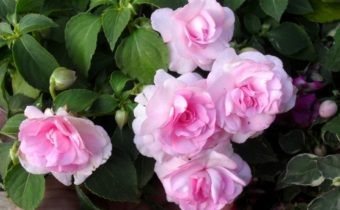

The rose is called "the queen of the flower garden" for a reason. Lush thorny bushes, covered with caps of large bright flowers, make any area elegant, create a festive mood. But a perennial rose is a capricious plant that requires painstaking care and special growing conditions.Not all summer residents or novice gardeners can afford to invite the "queen" to their garden.
There is an alternative to capricious roses - annual and perennial flowers, the flowering of which is similar to the flowering of roses. Most of them are unpretentious in care and not demanding on growing conditions.
Carnation
Terry varieties of garden carnations in appearance of inflorescences resemble peonies. Translated from Greek, carnation means "flower of Zeus". Flowers grow one at a time or in bushes, 2-3 inflorescences each. The flowers are lush, velvety, with a double border at the edges of the plates. Almost any color can be used. The leaves are green, with an unusual cereal-like shape.
Features of growing a carnation and caring for it:
- propagates by seeds and layering;
- there are annual and perennial varieties;
- perennials are transplanted every 5 years;
- feeding with humus is applied once a year, after flowering;
- grows well in higher elevations;
- watering is moderate, the plant does not like excess moisture.
Carnations are not only grown for cutting. They are used as a design element for rock gardens, curbs and retaining walls.
Peonies are beautiful and bright, but quite capricious in growing flowers. But there are more unpretentious plants that are similar in appearance. These include peony rose and poppy, ranunculus, double varieties of carnations. They do not require complex care, while in appearance it is sometimes difficult to distinguish them from real peonies.
What are the names of flowers that look like roses
The most popular doubles of a rose among domestic gardeners are: begonia, eustoma, balsam, terry begonia, ranunculus. Indoor plants include hibiscus, gardenia, geranium.
Ranunculus
Asian buttercup is the second name of this cute unpretentious flower with bright buds, similar to small roses. Homeland of the plant Asia Minor, garden plant species native to Turkey. A kind of flower - Persian ranunculus has a complete resemblance of a flower with a pink bud.
The height of the plant ranges from 30 to 80 cm. Flowers bloom on the bush with a diameter of 4-8 cm, pink, yellow, white, lilac shades.
For buttercup, areas with lacy shade and loose fertile soil are suitable. Humus and complex compositions of mineral fertilizers are used as fertilizers. Landing pattern 15 by 25 cm.
- in watering;
- weeding;
- removal of faded inflorescences.
In the fall, ranunculus tubers are removed from the soil, dried and stored in a cool and dry place until spring.
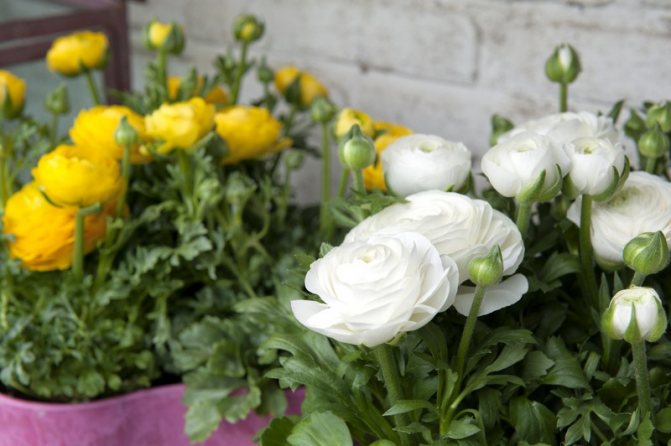

Eustoma
Eustoma or lisianthus is called "Irish rose" for the similarity of a delicate bud with a rose flower. The plant reaches 90 cm in height. The branchy bush can bear up to 30 open buds at a time and looks like a rose bush without thorns. The diameter of delicate flowers reaches 14 cm. The petals are colored blue, blue, white, red, pink and yellow. The varieties that form a purple flower are attractive.
For eustoma, sunny areas are prepared, protected from the wind, with fertile soil. Seedlings are planted in the ground when the last frost is over. Planting scheme of bushes 30 by 50 cm.
Care consists in regular watering with warm water and fertilizing with mineral compounds during budding and flowering.
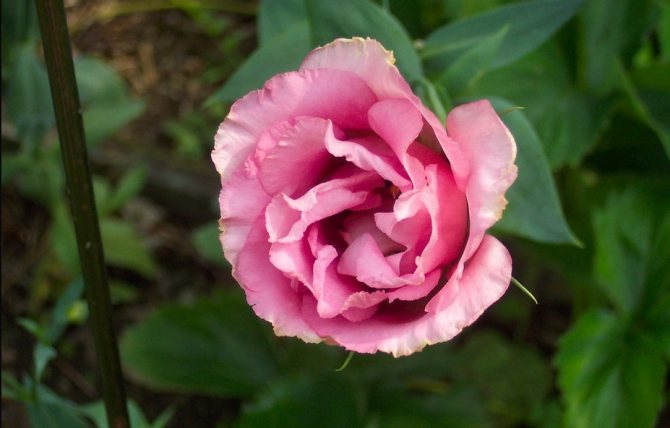

CrispyRice, Flickr
Terry balsam
A compact plant that looks like a dwarf bush rose. Plant height does not exceed 60 cm. Abundant flowering, white, red, pink flowers are found.
Balsams are planted in areas open to the sun or in lace shade. They can be grown not only in the garden, but also at home, like an indoor flower.
The culture loves loose and moist soils, with an admixture of peat and a high humus content. Regular watering is carried out with soft warm water. In the summer heat it is useful to wash balsam leaves from a watering can.
A herbaceous unpretentious perennial pleases the gardener with large and fragrant flowers, similar to peony roses. Common petal colors are white, burgundy, pink. The buds bloom at the end of May - June.
The peony is planted with cuttings of rhizomes in open sunny areas in the spring. The soil is necessary for the plant nutritious and moisture-absorbing. Fertile loams or sandy loams are suitable, in which mineral fertilizers and compost are applied.
Peonies need minimal care - watering in drought, feeding during flowering. Adult peony bushes do not require shelter for the winter.
In one place, a peony bush can grow up to 50 years.
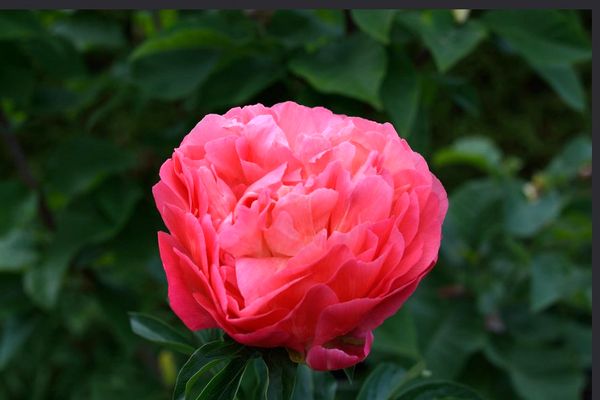

Ting Chen, Flickr
Rejuvenated or stone rose
A succulent plant that forms a rosette of fleshy green leaves, similar to a green rose. The similarity gave birth to the second name of the plant. The diameter of the leaf rosette can reach 20 cm, and the color of the leaf plate can have a bluish or burgundy tint.
The stone rose is unpretentious and grows beautifully in the garden and in the apartment. The plant needs bright sunlight and a sandy loose substrate. Soil for succulents is prepared from a mixture of sand, garden soil and vermiculite.
Watering and feeding the young is almost not required. At home, the plant is watered once a month, fed with complex mineral fertilizer 2 times a year, in spring.


Bred varieties and hybrids
Rose Ingrid Bergman
To date, more than 60 varieties of Irish roses have already been bred. All of them are divided into small in stature - short and tall. The former are used for keeping at home, the latter - in an open area, in a garden. In both cases, eustonia looks great, perennial flowers are a worthy decoration of the space. In texture, flowers can be either double or ordinary. Coloring in the most unimaginable shades.
Garden eustoma - varieties: Aurora, Echo, Heidi, Flamenko and others.
Indoor varieties: Mermaid, Little bell, Florida pink, etc.


Indoor varieties
Previously, only professionals were involved in cultivation. Now it is within the power of an amateur florist.
Indoor flowers that look like roses
The list of indoor plants that resemble roses in their flowering is not small.
Hibicus
One of the most popular and unpretentious home flowers is the Chinese rose or hibiscus. Terry variety forms a large red flower, similar to a slightly disheveled open pink bud. There are hibiscus with white flowers. The diameter of the opened flower reaches 25 cm.
Hibiscus, depending on the variety, can reach a height of 50-70 or 160-200 cm. Its foliage is large, slightly pointed. Flowers form at the ends of young twigs and bloom for only one day.
The Chinese rose requires:
- loose and fertile soil;
- diffused lighting;
- high air humidity.
In summer, the flower can be taken out into the garden or on the balcony, placing the plant in a lace shade.
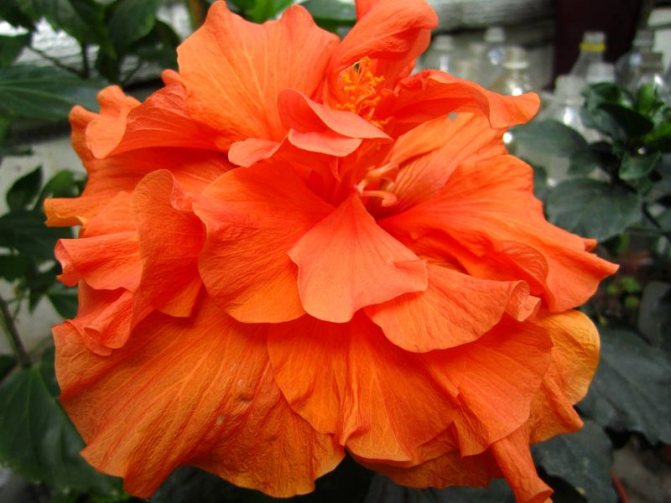

Gardenia
Jasmine gardenia is a tropical guest, forming white flowers, similar to roses.
A compact gardenia bush is grown in an acidic peat substrate, keeping it constantly moist. Comfortable temperature for a flower is +22 degrees.
Water the gardenia only with warm and soft water. She does not tolerate bright sunlight - delicate leaves get burned.
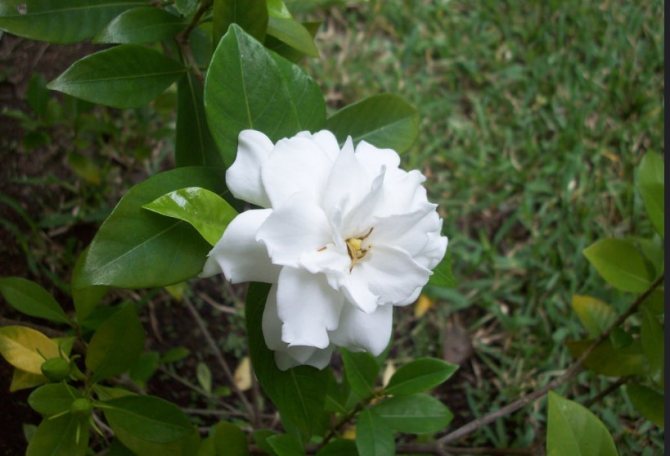

Begonia
Tuberous begonia is not easy to grow, but very beautiful plant. There are varieties with large (up to 20 cm in diameter) flowers on a small bush. For example, a hybrid of begonia with a yellow Primari flower.
The plant is placed on the eastern windowsill, protecting it from drafts. He needs a nutritious and loose soil.
For long flowering, begonia is fed every 15 days with a complex mineral fertilizer.
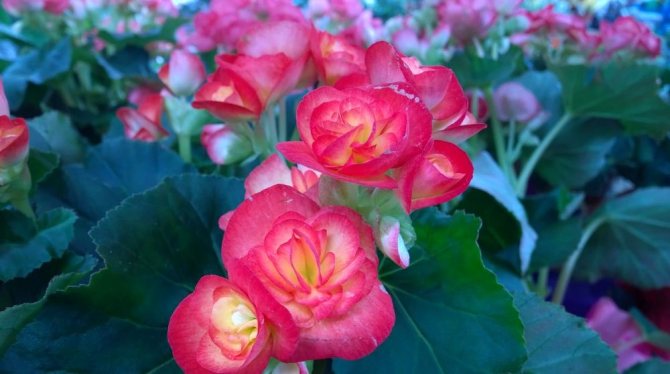

LongitudeLatitude, Flickr
Pelargonium
Pelargonium (in common parlance - geranium) pink or rosaceous forms inflorescences, similar to miniature bouquets of roses. The petals are pink, white, scarlet, salmon colored.The plant is unpretentious and pleases with long flowering all winter. In warmer months, geraniums can be planted in the garden.
At home, pelargonium is placed on the east window (the flower loves diffused light). The plant needs a cool wintering with an air temperature not higher than +20 degrees.
Watering is carried out with moderate, not cold water. Blooming pelargonium is fed with a complex mineral fertilizer for flowers.
Geranium propagates by cuttings, which are easy to root in water.


Pelargonium Millfield Rose
These flowers, similar to roses, can please an amateur who does not dare to start growing a capricious beauty yet.
Roses are wondrous royal flowers for all time. There are rare flowers that look like roses, they are also beautiful and adorable. When you see them, an association with a rose immediately arises, but, of course, there are differences, there are no thorns - protection and a symbol belonging to only one queen - the rose.
Similar flowers are very similar to the rose and are attractive to gardeners: peonies, Kalanchoe, gardenia, primrose, ranunculus, geranium, terry balsam, adenium, begonia, eustoma. They do not have thorns and in their own way they are all beautiful and adorable.
Hibiscus
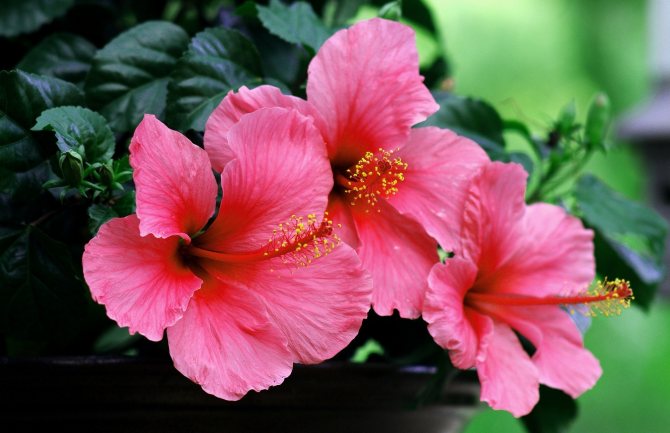

Hibiscus is a plant native to Southeast Asia and America. It has leathery elliptical bright green leaves. The flowers are single and large. There are varieties with wavy, double, simple and split buds. The color can be varied: yellow, white, pink, scarlet and red
The flowering period of hibiscus begins in May and lasts until the end of August. Most of the buds open and wither by the evening. Common types:
- Chinese rose. It is a shrub variety with double and cupped flowers. Diameter - 12-15 cm.
- Syrian. The compact shrub has erect leaves. The buds are funnel-shaped in white, pink or cream-colored.
- Sudanese kind. This shrub has dark red buds that reach 20-25 cm in diameter.
The plant is recommended to be planted in areas with diffused light and nutritious soil. Heat-loving varieties can grow in pots from the soil. They should be taken out into the garden or balcony.
Ranunculus - a flower that looks like a rose
The Asian buttercup with various shades became known for the first time in Eastern countries since the 16th century. The beautiful flower is a worthy competitor among some garden favorites. It resembles a peony and a rose, resists many diseases, is unpretentious in care.
Depending on the variety, the color can be pink, white raspberry, red, yellow, orange... When blooming, flowers reach up to 7 cm in diameter, are very similar to small roses, form several buds when they reach a height of 30-35 cm.


Flowers last a long time, do not fade, after cutting, they are originally combined with other flowers in bouquets. Ranunculus is able to decorate any garden, it grows well at home in pots, but it is thermophilic, and quickly fades in the cold. Suitable for planting seeds or bulbs directly into the ground.
Beauty eustoma
The attractive plant, which came from the American continent, is called by different names. Eustoma, lisianthus or Irish rose is endowed with delicate buds that, when opened, resemble roses.
There are simple and terry forms. The diameter of the opened flower reaches 7 - 8 cm. The color of the petals is varied, but delicate shades prevail. White, pink, purple, colored-bordered specimens are found in the gardens of hobbyists who grow rose-like flowers.
The plant reaches a height of more than half a meter. The stems are highly branched. Several buds are formed on each of the shoots. As a result, one branch looks like a bouquet of roses. Eustoma does not fade in a vase for a long time. In some of the advanced "flower" countries, lisianthus is among the top ten crops grown for cut. There are biennial and annual varieties.Amateur flower growers prefer to plant the latter on the site.
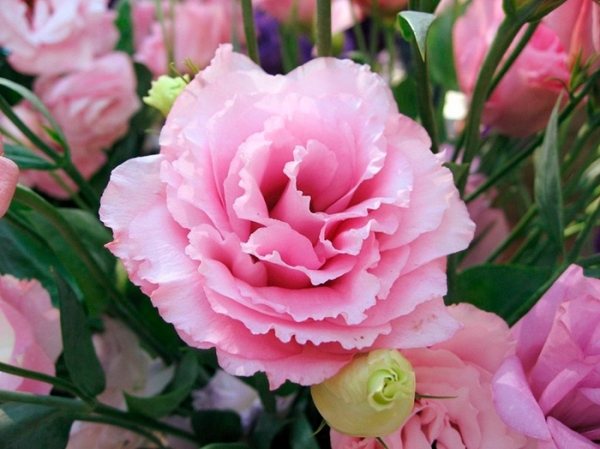

Eustoma
Of the popular varieties and hybrids, the following are most common:
- Misty Pink;
- Misty Blue;
- Blue Rome;
- Champagne;
- Deep Blue;
- Rose Pikoti.
The listed plants are distinguished by strong shoots and beautiful, rose-like, double buds.
Hibiscus - Chinese rose
Hibiscus, or Chinese rose, looks very much like a rose. This plant is not only indoor, but there are also hybrids, preferably grown in the garden. A perennial flower, luxurious bushes with buds form in the second year after planting. It blooms like an exotic plant, it is impossible to look without admiration.
The homeland of hibiscus is Asia, but today the plant grows beautifully in all countries of the world. The Chinese rose is compared to a symbol of beauty, sophistication, femininity.
The flower has 5 petals, which corresponds to the 5 commandments of Islam. The hybrids are quite adapted to our conditions and climate. They grow in bushes, like a rose, they are not afraid of frost, but they need to be covered for the winter, otherwise the roots and leaves may freeze.
There are a lot of buds on each branch, and the duration of flowering is only 1 day, but new buds immediately bloom, which makes flowering simply continuous, until mid-late October.
Hibiscus of deep pink shades grows up to 2 meters in height, flower diameter 23-25 cm. The bushes of this plant are a wonderful decoration for any garden.
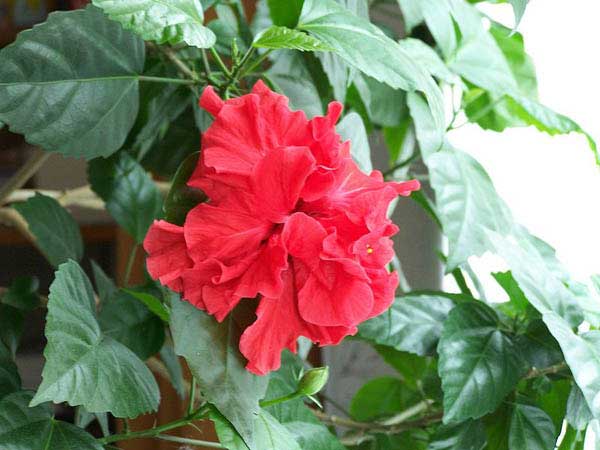

Peony roses
Another flowers, simultaneously similar to a peony and a rose, are called so - a peony rose. This fragile plant reaches


height 2 meters, blooms profusely and does not require complex maintenance. It grows quickly, forming many shoots - lashes. A peony rose differs from a peony in characteristic features:
- grows profusely in width, forms a large number of whip-like shoots;
- flowers have a pronounced cup-shaped, pompous or rosette shape;
- in cloudy weather, the flowers emit a faint pleasant aroma.
The most popular varieties of peony roses among gardeners:
- Rose de Mai, she is a May rose. A decorative variety of rose hips with a delicate aroma. Rose oil is obtained from the flowers.
- Rose Austin. The flowers are slightly smaller than those of a peony, with a pronounced aroma. It blooms 2 times a year.
- Sweet Juliet. Lush, multi-layered inflorescences of pale pink color. After blooming, a delicate aroma is spread.
- Eden Rose. The variety is distinguished by an unusual terry type of inflorescences. Blooms from spring to early autumn.
Most peony rose varieties grow well both outdoors and indoors. When grown in a greenhouse, they are able to replace peonies all year round.
Eustoma
Eustoma is a worthy competitor to the queen-rose. This touching delicate flower is a favorite of gardeners. The homeland of the plant is South America, but there are many hybrids today. There are known varieties with cream, red, white, apricot, lilac petals.
Flowers smell like roses, it's easy to confuse. The flower has a wide geography in distribution, therefore there are several names: Eustoma Irish, Japanese, French.
If you properly care for the plant, then the inflorescences will be terry, juicy and luxurious. Flowers are propagated by seeds through. There are tall varieties of 60-90 cm - hybrids, they are branched like a bush, as well as dwarf ones. Six months after sowing, you can admire the luxurious flowering inflorescences.
Flowers grow both in the room and in the open field. The composition of the soil is sand and peat, but it is necessary to sow at t not lower than 23 degrees, until the first shoots appear, you need to keep it under the film. After the seedlings get stronger, pick the seedlings.
After the appearance of a real third leaf, they are transplanted into a flower bed if necessary. The plant loves light; when grown in a room in the summer, it should be taken out more often to the balcony, outside.
A bit of history
The herbaceous rose was discovered by Irish historian, botanist and physician Patrick Brown in the 18th century.Perennial eustoma became widespread first in European countries, later, in the 19th century, flowers began to be grown in Russia as an ornamental home plant.
Great advances in flower cultivation were made in Japan in the 20th century. Half a century later, irish rose has achieved popularity and surpassed many other flower cultures. Common plant locations are New Zealand, USA, Australia. As you can see, not Ireland, as the name suggests.
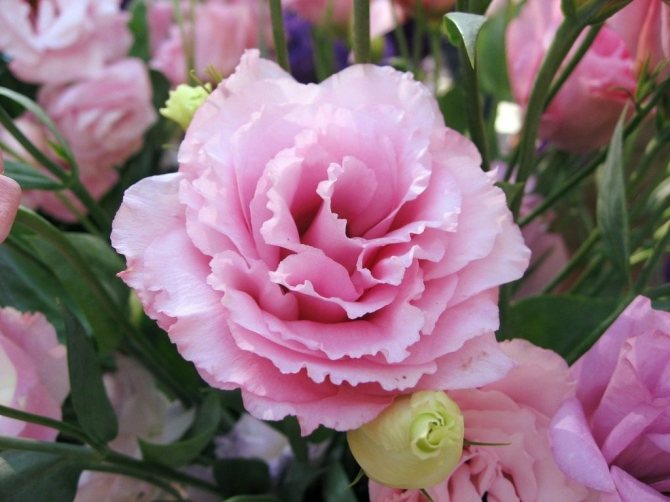

Irish rose
There is a beautiful legend associated with the appearance of a flower: a beautiful young girl did not agree to the proposal of the spirit of war to become his wife. This was the reason for her death. Grass grew on the grave and here the Irish rose first appeared.
Begonia
Begonia is one of the most common home flowers, a competitor to the rose and a favorite of gardeners. Plants bloom well, are unpretentious in care. The birthplace of begonias is Africa and South America, there are more than 900 of its species.
The sizes are different: miniature and giant bushy growing up to the ceiling in the room. Caring for begonias is easy. The main thing is that the soil is moist and water does not stagnate. For this it is necessary to make drainage.
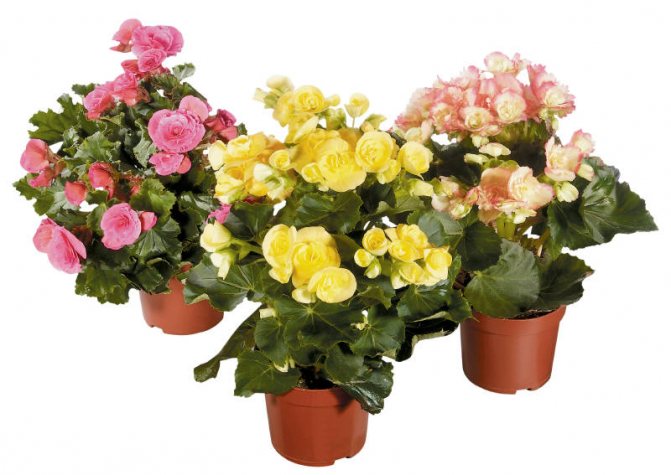

How to care for a bouquet to make it last longer?
When purchasing blue, purple, pink, white flowers, similar to roses, the name of which is already known - eustoma, you need to provide them with proper care. For this you need:
- Cut off the ends of the stems obliquely, remove the leaves from the bottom, which will be below the water level.
- Put the plants in cool water, bottled, spring, filtered, settled tap water will do.
- Add special agents that extend the life of flowers - thanks to the additives, the smallest buds will open, the eustoma will remain fresh twice as long.
- The solution should be changed regularly and the vase should be rinsed as the plant is sensitive to bacteria.
- The flower quickly evaporates water, for this reason it is undesirable to place it in the sun or near heating devices.
Depending on the degree of maturity of the flowers, the correct care, feeding, the decorative effect of a bouquet with lisianthus will last from 7 to 14 days. It also matters how the compositions were stored prior to purchase. Therefore, special storage and transportation conditions are created at the flower bases of Mostsvettorg so that you can always buy the freshest and very beautiful flowers!
New types of geranium
Geranium has no thorns, but is very similar to a rose. It grows beautifully on the balcony, windowsill, flower bed. It is believed that by planting a flower near the house, there will be no discord and bad weather in the family, and white inflorescences will increase the fertility of the family. Geranium is not only beautiful, but also creates a favorable microclimate in the house.
The birthplace of the flower is Africa. More than 280 species are known. Terry inflorescences with many petals are comparable to rosebuds, their full disclosure does not occur. Geraniums should not be watered abundantly and kept in the sun, but the soil should not be allowed to dry out either.
For air penetration, it needs to be loosened more often, fed with top dressing. Water preferably with warm water.


Flowers are like roses, but not roses - what's the difference?
Among the many flowers, there are always those that repeat certain features of other plants, but belong to a completely different species. Eustomas are flowers similar to roses, but not botanically related to them. What is the difference between these largely similar plants?
- The homeland of eustoma is considered to be an area in Central America, covering the southern part of the United States and northern Mexico, therefore the flower in these parts is often called the Texas bell. Roses were brought from the southeast of Asia.
- The natural colors of eustoma are various shades of blue and white. Today, a graceful flower pleases us with the widest range of colors: these are all shades of lavender, red, purple, white, blue, pink, green.In addition, eustomas are grown in a variety of pastel shades, as well as the famous edged varieties, which have white petals with bright colored edging. In the color scheme of roses, there is no pure blue color and shades of blue.
- Two outwardly similar flowers have completely different characters: the rose is majestic and unapproachable, the eustoma is gentle and delicate, devoid of the nature of sharp thorns. The stem of the Lisianthus is more tender, there are no woody areas on it.
- Eustoma has a subtle, almost absent aroma, due to which bouquets with it can be presented to those who cannot stand intense floral scents.
- Unlike roses, it will not work to grow a flower from an eustoma cuttings - it reproduces only by seeds. But since lisianthus naturally grows in arid regions, its hardiness extends to specially grown flowers.
In addition, there are many scientific botanical differences regarding the structure, morphology, growing conditions of these two plants.
Terry balsam
People call balsam Vanka wet. Flowers, like roses, are very similar to them. Plants of short stature are perfect for landscaping the territory; they bloom profusely and grow on windowsills even in winter. Can be planted with seeds, cuttings in open ground. Thanks to the various shades, planting several varieties in one flower bed, you can get real flower splendor.
You do not need to water often, but it is necessary to loosen it periodically. Drying out, soil compaction should not be. Plants love shade, grow well under trees, in flower beds, as well as in vases, pots, baskets, containers. The flowering is generous. There is no need to oversaturate the soil with moisture, otherwise the stems will become brittle and fragile.
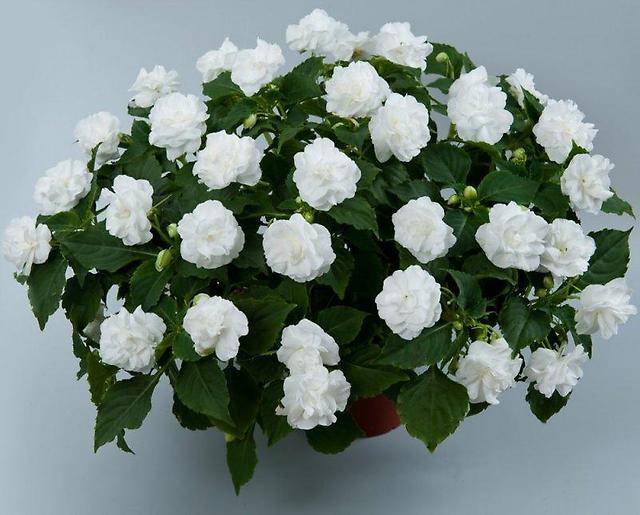

Indoor flowers that resemble a rose
Among indoor plants, there are several flowers that look like a rose in their bright buds. It:
- Chinese rose;
- begonia;
- geranium.
Below is a brief description of these long-term flowering houseplants with photos of their bright and very beautiful flowers.
Hibiscus (Chinese rose)
The hibiscus flower looks more like an eustoma, but its double varieties resemble ordinary roses in appearance. The plant is often grown as an indoor plant, but sometimes for the summer it is put in a pot on an open balcony or terrace. The Chinese rose blooms for a long time - from July to September, delighting with lush large buds.
There are few hibiscus colors, but they are very bright, saturated red-brick, burgundy, pink. With regular grooming, hybrid varieties can gradually open up to 20 buds on one branch.
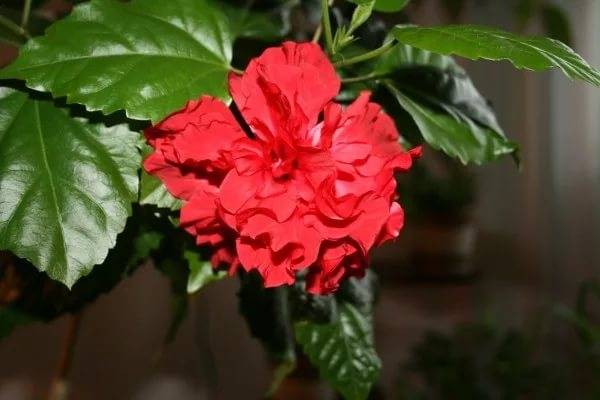

Herbaceous or tuberous begonia
Begonia is grown as a pot culture and in the open field, planted in the garden in the summer in flower beds, in hanging pots. Many different varieties of this plant with bright colors of inflorescences have been bred. Begonia, unlike a capricious rose, is quite unpretentious, blooms for a very long time. The most popular shades of buds are white, pink, red-scarlet and cream.
Small buds resemble miniature roses, collected in numerous inflorescences. Petals differ in shape, terry. The leaves are large, dark green, the stem is erect or creeping, depending on the variety.


Geranium (pelargonium)
Lush inflorescences of room geranium (the second name of the plant is pelargonium) from afar resemble bush roses. Especially similar to their buds are rosebud and rose-like varieties. It seems as if many miniature roses the size of a coin are collected in a huge bouquet. There is a similarity in colors - varieties with white, pink, red flowers, shimmering in shades of scarlet, crimson, and having a variegated color are popular among flower growers.
With proper care, indoor geranium will delight the owner with abundant flowering for several months. Up to 7-12 buds can appear on one bush at the same time. The main thing is to protect the leaves from sunburn, water the soil in time and apply top dressing.
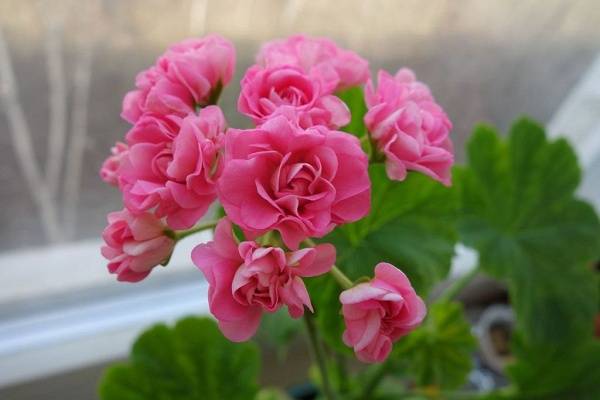

In addition to the above garden and indoor crops, other flowers have a distant resemblance to roses:
- outdoor gardenia - indoor flower with dark green leaves and very lush white inflorescences, which eventually acquire a cream color;
- terry balsam - a plant that resembles very small roses in bloom with pink, snow-white or creamy-scarlet petals;
- Terry primroses are dwarf shrubs with many buds and open flowers that have yellow, crimson, white or pink hues.
Gardenia
In terms of aroma, gardenia resembles jasmine, and in appearance, of course, a rose. The plant is majestic, but loves warmth, affection and care. Depending on the species, it grows dwarf or tall in size. The flowers are arranged in pairs, but rather large, of cream and white shades with dark green shiny leaves.
Flowering occurs in mid-summer and up to the month of October. Grown small bushes up to 0.5 meters high will become a real decoration of any interior. Bushes do not tolerate the scorching rays of the sun, but a lack of light will lead to stunted growth.
It is better to place the flowerpot on the southwest side. If there is a lack of lighting, you need to put a fluorescent lamp next to it.
Water the flower regularly, but in moderation, 1-2 times a month with the addition of citric acid. The soil should be slightly acidic. It is not recommended to spray flowers.


Growing, features
Irish rose is a plant that prefers diffused light. The most suitable soil is humus with peat, mixed in the same proportion.


Features of the Irish rose
Rose Poetry
A feature of the plant is that reproduction occurs exclusively by seeds. Watering is allowed only when the soil is dry enough (2 cm deep into the soil).
Important! When replanting a plant, you need to be extremely careful.
Better to give it up altogether. The root system is fragile and prone to damage. The optimal condition for keeping is a cool room with free air passage.
Terry adenium
Adenium is considered a rose growing in the desert. Flowers can decorate any greenhouse or garden. It is a bushy succulent, the leaves are huge, olive-colored, and the flowers are graceful, with many different colors: white, red, with ebb.
The appearance of buds begins in early June and until autumn. They delight the eye with their luxury and splendor. The homeland of adenium is Central and South Africa.
When planted in the ground, the stems can reach up to 10 meters. At home, the height does not exceed 35-40 cm. Adenium blooms wonderfully, many owners strive to breed it in garden plots, but the juice is poisonous, you need to handle the plants carefully.
It is good to keep it outdoors in summer, fresh air speeds up the development process, but often it is not necessary to water. Leaves can be lightly sprayed, but water should not get on the inflorescences.


Irish Rose from Seed
To grow eustoma at home, you need to be patient and spend a lot of time and effort. Here it is important to master all the subtleties of the growing process, care. If you take it seriously, responsibly, then the result can be simply amazing, exceeding all expectations. Since the plant is becoming more and more in demand among florists and florists every year, this may well become a profitable business. The difficulty in sowing is the small size of the seeds. 23 thousand pieces are only 1 gram.
The planting scheme is as follows: seeds should be sown in late winter - early spring. The soil needs sterile, fertilized with some nitrogen. It is necessary to pour the seeds onto a plate, cover them with glass on top so that fresh air flows to them. You need to use artificial lighting so that the daylight hours are 10-12 hours. The temperature should be around 20 degrees. 60 days you can not water the future plant. The first shoots are visible after a couple of weeks. It is worth removing the glass and spraying them with a phytosporin solution.Transplanted into a larger container only when leaves appear. After three months, the plants are transferred to open soil.


Rose seeds
Hellebore
The plant is poisonous, but became famous among the people for its healing properties. The frost-hardy black rose is a perennial evergreen that reaches a height of 30 cm with good growth, suitable for indoor cultivation. The roots grow long and creeping, so the hellebore pot should be tall enough.
A mixture of garden soil with clay is suitable as a soil. To drain moisture, you need to put a drain on the bottom of the pot. The plant grows well in a cool, shaded area. After cutting, the hellebore stays in water for a long time, up to 1.5 weeks, but the water needs to be changed periodically.
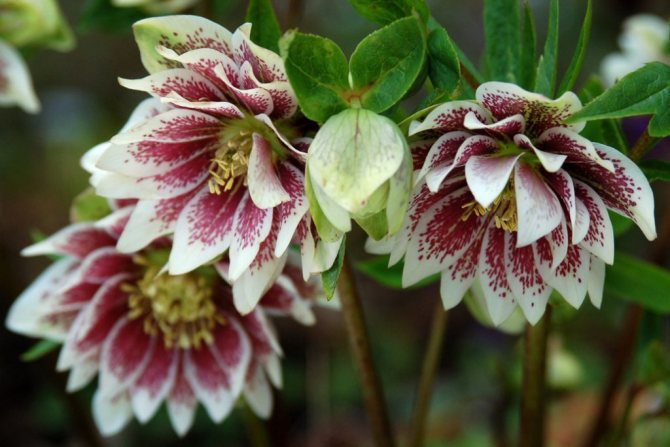

Of course, the queen of any flower garden rightfully remains a rose, but all the listed flowers are very similar to it, in their own way they are magnificent and worthy of a place in any garden.
Rose favorites are able to decorate any garden plot: flower bed, windowsill, balcony. There is no need to doubt the luxury of these flowers, but you need to observe the peculiarities of growing each of them. Plants grow, bloom, and therefore live, require love, affection and proper care.
The main diseases and pests of culture, control measures
The plant is susceptible to fungal infections. With high humidity in the summer, it is worth treating the eustoma with fungicides as a preventive measure. Powdery mildew is also a common disease. It looks like a white bloom on leaves, shoots. It occurs at low temperatures and high humidity. To cope with it, it is worth spraying the plant with Sarolem, Topsin. In total - two or three treatments.


Eustoma diseases
Fusarium wilting is a dangerous disease for eustoma. If present, the stem softens and wilting begins. It can begin if the soil under the flower is dry for a long time.
Among the pests can be snails, aphids, slugs. To eliminate them, the plant must simply be treated with Fitoverm, Mospilan, Confidor.
Eustoma is a beautiful plant that requires careful care. For experienced flower growers, it will not be difficult to grow it at home, as well as in a garden plot.
Flowers that look like peonies - photos, names and cultivation features
Adding an article to a new collection
A beautiful and sophisticated bouquet cannot be imagined without peonies. These luxurious and lush flowers are loved by many summer residents. But is it possible to plant any other plants on the site that will resemble familiar peonies and at the same time do not require maintenance?
Peonies are one of the most gorgeous and desirable flowers in any summer cottage. But it is believed that they are quite picky in growing, and not all summer residents manage to maintain them in a healthy state, divide and replant them in a timely manner. Therefore, many find a replacement for peonies and choose flowers that at least outwardly resemble their favorite culture.
Tulips like peonies
How many petals do spring primroses have - 5-7? No, peony varieties have more than 20 of them! Imagine how beautiful the bouquet looks when each the bud reveals several dozen colored petals
.
The first double tulips appeared more than 4 centuries ago, but still less than 10% of the market is devoted to these flowers. The idea of the tulip as a modest, non-fluffy plant is too deeply rooted. We urge our readers to break stereotypes and enjoy peony tulips before the season of their large-doubled counterparts has yet arrived.


Now you know, what can be used to replace peonies before their season arrives.
It turns out that the choice is very large, and every month you can please your beloved with voluminous and bright compositions.
The characteristic signs of a carnation
Flowers can be grown either singly or in groups of 2-3. The flower cups are usually cylindrical with several pairs of bracts. Velvety petals with fringed plates. Coloring them can be absolutely any.
Clove has medicinal properties
The fruit of a carnation is an elongated capsule with many black seeds, which are round, oval or flattened. The leaves are green, gramineous, and can be colored in different shades of green. Carnation is great for decorating borders and rock gardens, flower beds and retaining walls.
Characteristic signs of ranunculus
The plant usually reaches a height of 20 to 80 cm, with strong stems and dissected leaves. Inflorescences are densely double, double, semi-double, their color is a wide range of shades, with the exception of blue and light blue. The diameter of the flowers is 5-10 cm, and at the beginning of flowering they resemble roses, and when they open, they look more like poppies.
Usually no more than 70% of the planted ranunculi take root.
Ranunculus juice is poisonous, therefore, the plant should be handled carefully.
Classification of roses according to various characteristics
| Austin Roses awarded the Brin Royal Horticultural Society's Quality Mark: |
|
| Recommended varieties for growing in Russia |
|
| Varieties that can be grown as climbers |
|
| Varieties for container growing |
|
| Continuous flowering varieties |
|
| Very large flowered varieties |
|
| Varieties that do not require support when growing |
|
Gardenia street
The flower, not only is almost completely similar to a rose, but also ideal for keeping at home, but for the original it is almost impossible. Gardenia has differences in size: dwarf, tall or medium-sized. But in appearance, it is most often in one version: white (when it fades, it is already creamy) with bright green leaves. Here the care is also quite simple and unpretentious:
- You need a lot of light, but not sunlight, it, on the contrary, is contraindicated. A very convenient plant for dark apartments located on the north side.
- Watering is needed regularly, but you should not allow waterlogging of the soil.
- Fertilization is required only once a month; you can prepare the mixture for this yourself. This should be acidified water, which must be injected at the root.


The aroma of this flower does not in any way intersect with the usual scent of a rose, on the contrary, it is rather heavy, closer to jasmine. Planting should be carried out only indoors, as well as the location, this culture is not suitable for growing in open ground.
What are the flowers that look like peonies?
Flowers similar to peonies - what are the photos, what are they called?
Now a lot of things are bred pion-shaped. But best of all reflect the structure of the peony, its terry, these are peony roses.
These roses are quite expensive, so bouquets of peony roses are as expensive as those of Dutch peonies. After all, our peony season is short, that's when you can cut a peony from the garden, and it won't cost you a penny.
There are also peony tulips, which are also very beautiful, but not very durable.
They look like a peony in the shape of a flower: terry mallow
Less similar aster Chinese peony
There are three types of similar colors. Peony rose, also called “ostinka”. This decorative flower is unpretentious, bred about 50 years ago and is unusual in a variety of colors. Distinguishing it from a peony can be difficult.
Ranunculus or Asiatic garden buttercup.
Asiatic buttercup (ranunculus). Perennial, not tall - 40-50cm .:
Peony poppy. Up to 1 meter high, flowers reach 15cm in diameter. They bloom quickly, but if the seed pods are cut off, new buds appear. The aroma is amazing.
There are quite a few flowers that look like peonies - I will list only the main ones.
Peony roses - they can be not only white, but also pink, red and other colors.
May rose also very much like peonies.
Asiatic buttercup a very beautiful flower, besides it has a large percentage of similarities with peonies.These flowers can also be of different colors.
I think this list would not be complete if there was no such flower as ranunculus.
I adore peonies, at my dacha several bushes of this beautiful flower grow, they begin to bloom in May, it's a pity they just fade very quickly.
The peony has a rather massive flower, its aroma is simply magical, on the last call, basically all schoolchildren come with bouquets of peonies.
The following flowers are very similar to peonies:
A peony rose, although its scent is completely different, slightly softer than that of a peony.
Also, a flower such as ranunculus bears a resemblance to a peony. True, this flower has more powerful stems and there are much more colors than a peony.
Another flower similar to a peony is the May rose, most often it is pink, although it is also found in burgundy and deep red colors.
Peonies and ranunculus: difference and similarity
Who would have thought that the Asiatic buttercup could compete with the royal double flower. But everything is possible in floristry. Especially Dutch unopened peonies resemble ranunculus. Both plants have dense, round buds.
Blooming ranunculi are approximately 6 cm in diameter.
On the one hand, this is a little compared to 10-12 cm for peony, but they are cheaper. Buy a few dozen of them, and you get a huge armful. For a girl, this can become a truly original and unusual gift. According to the observations of the florists of the Seven-Flower, men often give the usual flowers, buttercups for them are exotic, which they underestimate.
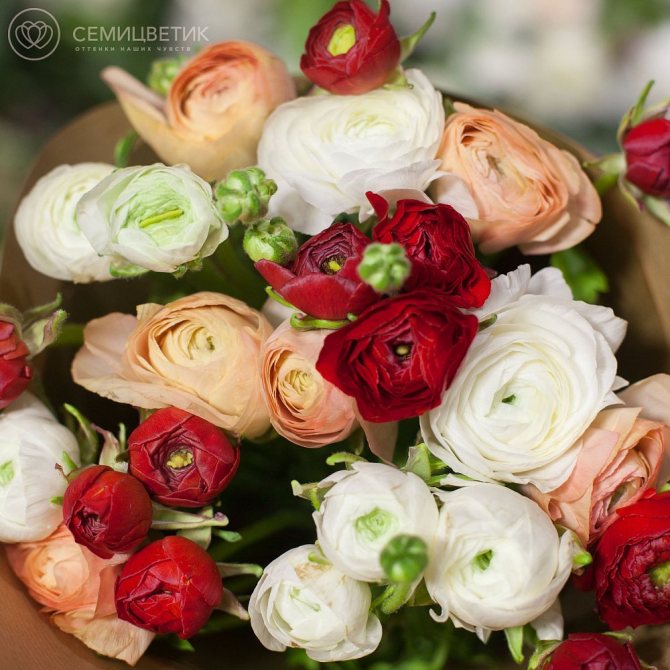

Terry primroses
As for the external data, then not only the resemblance to a rose is immediately evident, but also a special beauty, the flower seems to be painted with watercolors, it attracts more attention than a classic rose. Primroses are bushes on which small flowers up to 5 cm in size grow, depending on the variety. The palette of shades is also quite large: pink, and burgundy, and raspberry, and yellow. As for the exactingness, here everything is 5/5, because even with the soil you don't have to mess around for a long time - any will do. An open area or a pot - it doesn't matter.
There is a way to increase flowering. To do this, primroses are planted in loose soil, previously saturated with chemical elements, the place should not be sunny, and watering should be frequent, then they will delight with beautiful flowering for up to 4 months.
Nothing is perfect, so there is one thing - the process of formation and flowering is rather slow, the first bright buds will begin to appear only after a year, and this is with proper care.
Care
ITO peonies
In order for green spaces to grow beautiful, with powerful stems, bright and large buds, they need to be properly cared for.
- Watering the plants should be regular as the topsoil dries out.
- Loosening the soil after watering will provide its aeration, air access to the roots.
- Mulching will keep moisture in the soil and ensure its breathability.
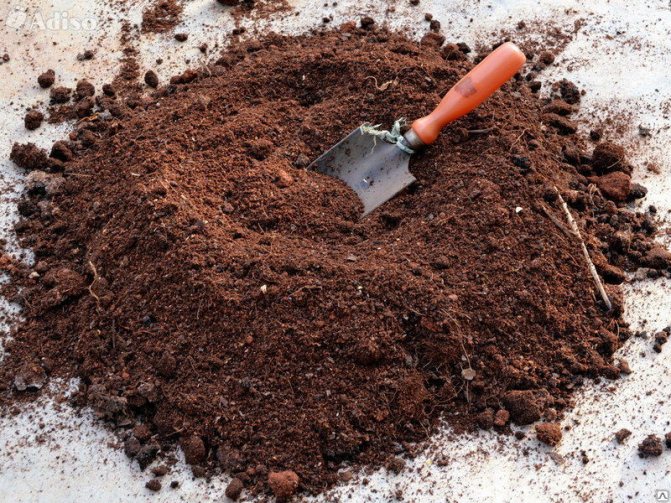

- In the spring, the first feeding of the plantings with nitrogen fertilizers, for example, rotted manure, is performed. If, when planting perennial plants, any nutrients were poured into the pit, then in the year of planting they are no longer fed.
- Bushes with long lashes need support, a garter.
- To stimulate the growth of lateral shoots, after flowering, the buds are removed from the bush.
- When signs of disease appear, the bushes are sprayed with appropriate preparations. The same is done when the bushes are affected by various pests.
Red hybrids
| WILLIAM SHAKESPEARE Characteristics and features of the variety:
|
| BENJAMIN BRITTEN Characteristics and features of the variety:
|
| MUNSTEAD WOOD Characteristics and features of the variety:
|
Description
Today, quite a few peony-like flowers are grown with different colors and texture of petals. Peony roses are gaining more and more popularity, although they appeared relatively recently. The bushes differ in their beautiful decorative appearance: they look like roses, and in structure and shape, which can be double or semi-double, are very similar to peonies.


The choice of varieties is quite wide, the color of the buds can vary from pale pink to purple or orange. There are also variegated varieties. Flowers have a delicate, pleasant aroma. Florists pay tribute to this species for the minimum demanding care and excellent resistance to disease.
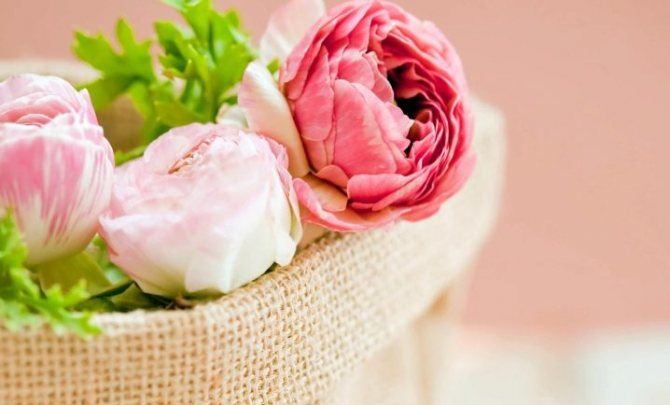

- Rose Austin bred by the English breeder David Austin. The plant forms both a familiar rose bush and has ampelous, curly forms. The buds are round, similar to a lush, multi-layered pompom. They come with a small and deep bowl. They look more like a peony than a rose, but differ from the first in a numerous color palette and aroma. The smell is not only pink, but there are also notes of citrus, peach, cloves, oriental spices.


- May rose or brown rose hips forms rather voluminous bushes with brown branches covered with thorns. The buds are bowl-shaped, small in size and similar in flower shape to one of the wild species of peonies "Maryin root". It blooms with a pink tint, although there are reddish-purple specimens.


- Sweet juliet has a lush bud with many petals and an incredible aroma. Blooms all summer and early autumn.


- Eden rose it is distinguished by large double flowers with a delicate scent. Flowering lasts quite a long time.


Terry mallow is a tall perennial with a large number of fluffy peony flowers with elongated petals of the most varied tones: white, pink, yellow, different shades of red and purple.
Due to its high decorativeness, the plant is not only often planted in plots, but also used for cutting.
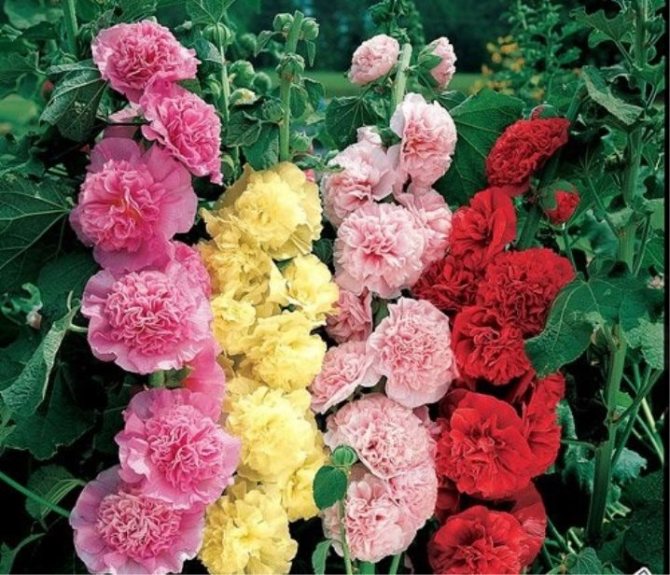

Terry begonia has inflorescences in the form of a volumetric bowl with a diameter of about 15 cm, which rests on a squat pedicel. Multi-layered buds bloom in white, pink, scarlet, amber or yellow.
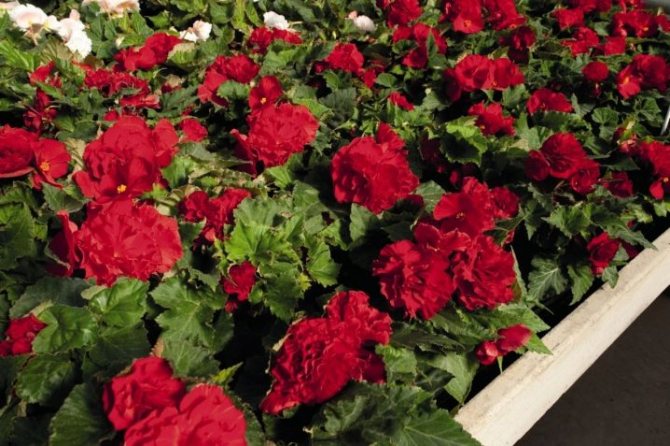

The pion-shaped aster is the most beautiful representative of its family. It grows up to half a meter, spherical flowers with a diameter of about 10 cm, painted in different colors. The flower is appreciated for the duration of flowering and immunity to diseases.
Due to the unusual appearance of the Chinese aster, beautiful bouquets are made that do not lose their freshness for 2 weeks.
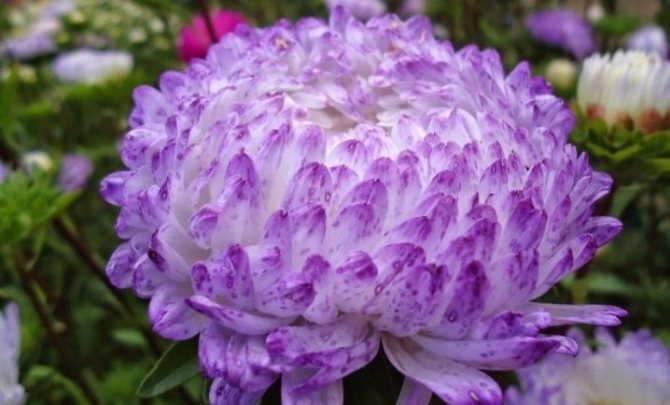

Ranunculus or Asiatic buttercup is a perennial plant that prefers damp, swampy areas for growth. Stems can grow up to 80 cm, peony buds have different color shades. Depending on the variety, they can be snow-white, pink, scarlet, yellowish, cherry, purple, even a light green tone. They also differ in shape, there are varieties with terry, semi-double or thick double bowls. Due to its unusually elegant appearance, the flower is often included in bridal bouquets.
Are there chrysanthemums that look like peonies
With the word "chrysanthemum", most represent bush varieties that resemble chamomile. However, the autumn flower is lush pump-shaped
... Single-headed chrysanthemums have more than a hundred identical, symmetrically located, slightly curved petals. Due to this, the inflorescence looks voluminous, but neat.
By the way, sunny yellow chrysanthemums look spectacular. Among the Peony family, only ito-hybrids have lemon shades, but they are not grown commercially.


Peony poppy
Terry peony poppy, or papaver, is an annual plant that is specially bred to imitate peony. The flowers are smaller, with many thin petals. Lush inflorescences of bright pink color resemble peonies in shape and color. It is a single flower on a long and slender stem, up to 1 meter high. Unpretentious to growing conditions, does not require complex care.
Features of growing peony poppy and caring for it:
- grown as an annual (when planted before winter, it can grow further with a self-seeding);
- grows well in a sunlit, open area;
- due to the tap root system, the soil layer must be deep enough;
- propagated by seeds or root cuttings;
- sowing seeds in open ground is recommended in early spring;
- the plant needs to be provided with regular feeding (retains the bright green color of the leaves);
- the soil around each flower must be loosened regularly, and then covered with mulch;
- moderate watering, it is undesirable to allow the soil to dry out.
The distance between adjacent flowers is not less than 20 centimeters. The plant does not like crowding, which is why it needs to be thinned regularly and weeds removed in time. The peony poppy is grown for cutting. It is used as an element of the Moorish lawn, rabatok and mixborders.
Planting roses
| Preparation:
|
| Landing:
|
An important point: Austin roses are quite resistant to shade and lack of sun, but they need at least 3 hours of light a day.
Twitterguru
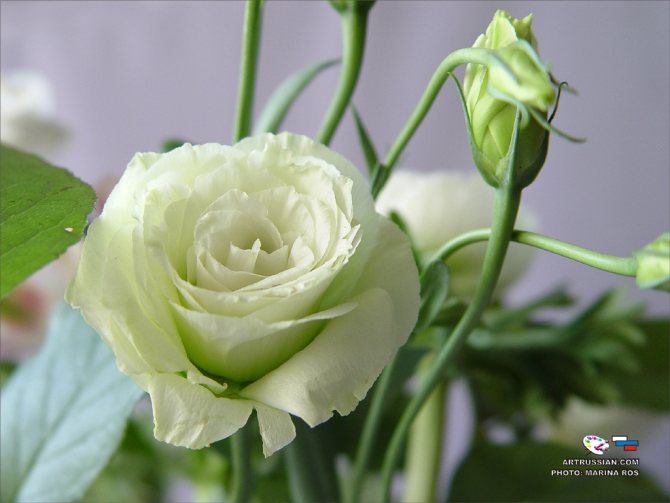

Long, haughty stems, delicate and fragrant flowers, impeccable perfection of velvety petals and sharp thorns that reliably protect this tremulous beauty from foreign, rough touches - all this is a rose, the queen of flowers. Not surprisingly, people, when trying to describe the beauty of other flowers, often try to compare them with the splendor of a rose.
It is amazing and unique, but there are several plants that nature, by its waywardness or whim, has endowed flowers like roses... These plants include:
- some varieties of geraniums, primroses, tulips and gardenias,
- adeniums;
- terry balsams;
- Chinese rose (hibiscus);
- peonies;
- ranunculus.
Possessing no less attractiveness than classic roses, these flowers are devoid of thorns, often much easier to care for and not so demanding on the soil. Let's find out what are the names of the flowers, amazing like roses. There are a lot of such twin plants in ornamental gardening, so we will focus on the most famous species. Let's talk about the similarities and differences of plants, especially breeding. You can buy seeds and seedlings of decorative flowers here.
Let's start listing titles and description flowers, like roses, with a guest from Asia Minor.
Asiatic buttercup
Ranunculus (Ranunculus asiaticus, Asian buttercup) - unpretentious and very pretty low (up to 40 cm) cbranches like a rose, brought to Europe from exotic Turkey back in the distant 16th century.For a very long time ranunculus was extremely popular with flower growers, then it went out of fashion and survived a rather long period of undeserved oblivion.
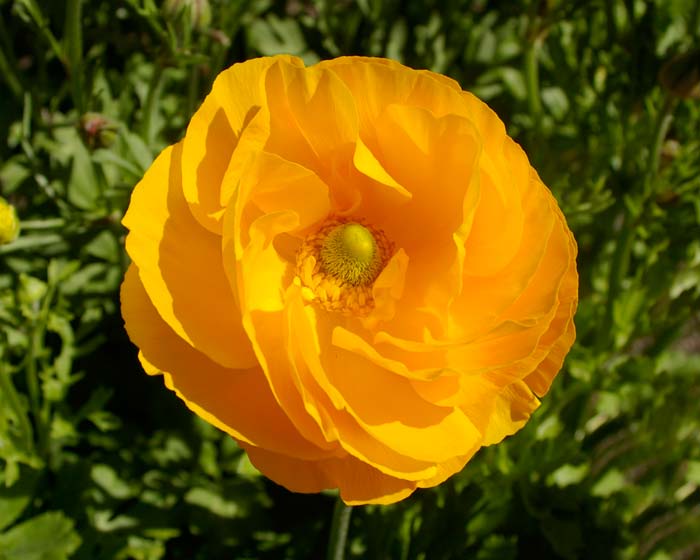

Today, these adorable multi-colored flowers are back in flower gardens and the hearts of gardeners and landscape designers. One of the main advantages of ranunculus is its exceptional unpretentiousness and resistance to diseases and pests, while its beauty is capable of being a worthy competitor to many more famous flowers.
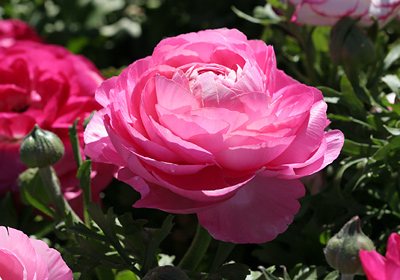

In the open state, ranunculus flowers reach 7 cm in diameter and in its shape the plant really is a garden flower highly rose-like, as well as terry poppy. Depending on the variety, flowers can be of a wide variety of colors - from yellow and orange to bright purple and crimson. Several buds bloom on each stem up to 30-35 cm long.
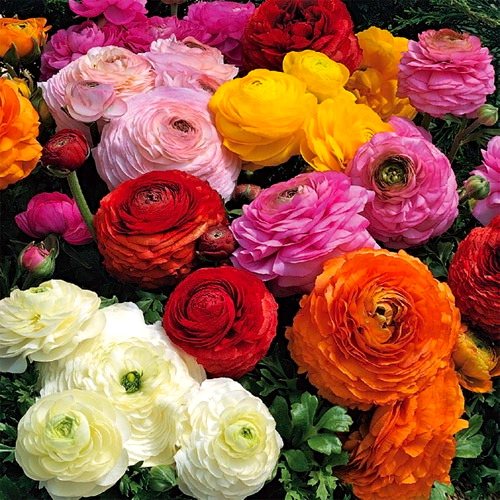

Due to the fact that ranunculus retain their freshness for a long time after cutting, they are increasingly used in bouquets, including wedding bouquets. Asian buttercups can be the best garden decoration, but they feel great in a pot on a warm terrace - the main thing is not to experience it with strong cold, which this delicate plant does not tolerate. This one multiplies rose and peony flower bulbs and seeds, there are both annual and perennial varieties.
Hibiscus
Hibiscus (Hibiscus rosa-sinensis Linn, Chinese rose) - bush flower, amazing rose-like without thorns, which is why it got its name. A fairly popular houseplant, but there is also its garden variety, which, a year after planting, grows into a powerful bush covered with buds.


The homeland of hibiscus is the warm and mysterious East, where beautiful red flowers are revered as a living embodiment of the Buddha's commandments, but as a result of many years of work of breeders, varieties of Chinese roses have appeared that feel good even in a rather harsh Russian climate, if you give them enough attention before wintering and cover the root system of fallen leaves and wood chips.
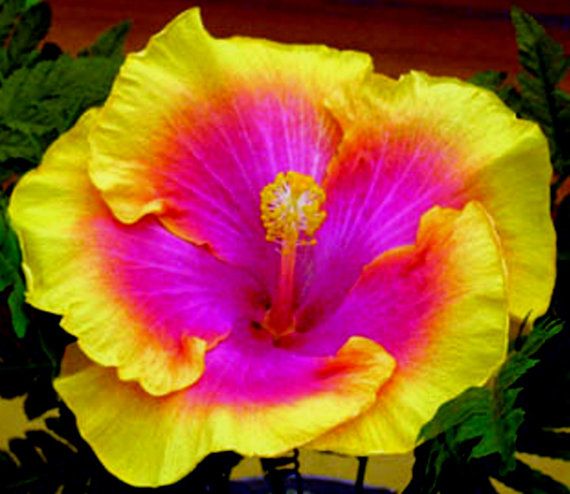

In addition to the traditional red hibiscus, there are like roses varieties with flowers different shades of pink. And thanks to the crossing of red, pink and holly varieties of the plant, a unique hybrid with a particularly lush flowering was obtained: on each branch it has up to fifty buds, each of which blooms in a day, but thanks to their large number, hibiscus blooms for months! Such a plant will be a worthy decoration for any garden and flower garden. Delicate hibiscus flowers that look like roses, will not leave anyone indifferent!


Eustoma
Eustoma is a surprisingly delicate and touching flower, also called a Japanese rose for its resemblance to the queen of flowers, although the plant was brought to Europe not from the land of the rising sun, but from Central and South America. Today, thanks to the persistent work of breeders, there is a wide range of varieties. rose-like eustoma a wide variety of colors: white, cream, lilac, purple, apricot, red, there are also varieties with two-color flowers. Eustoma flowers so look like a rose externally and aroma that they are easily confused.


Eustoma bushes can be both dwarf and tall, flowers are collected in lush inflorescences. Propagated by eustoma seeds, which are planted in pots filled with a light mixture of sand and peat. Seedling of these flowers also similar to seedlings roses... Low bushes feel great in a room or a veranda, the main thing is that they have enough light, eustoma are very light-loving plants.
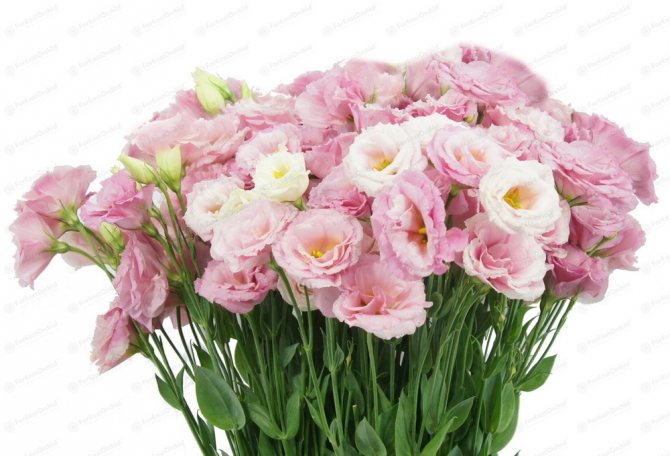



Begonia
Begonia (Begonia) - another flower, The same rose-like.
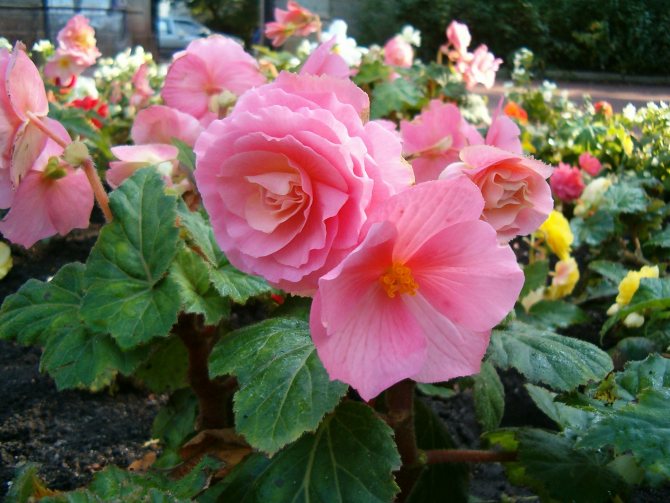

An exceptionally unpretentious and abundantly flowering plant. Almost a thousand varieties of both decorative flowering and decorative leafy plants belong to begonias, like roses varieties with large flowers... Shades of buds can be very diverse: there are varieties with white, yellow, cream, bright red, pink, burgundy flowers. Florists are especially attracted by the unpretentiousness of begonia: it grows well both in the sun and in the shade, it is undemanding to the composition of the soil - the main thing is that the soil is not too heavy and water does not stagnate in it. Begonias usually grow in an apartment, but in summer they thrive in a flower bed or in a flowerpot, and even on a roadside.


What begonias are flowers surprisingly similar to roses without thorns, say all lovers of decorative gardening.




Geranium
Geranium (Geranium) is a popular houseplant brought to Europe from Africa.
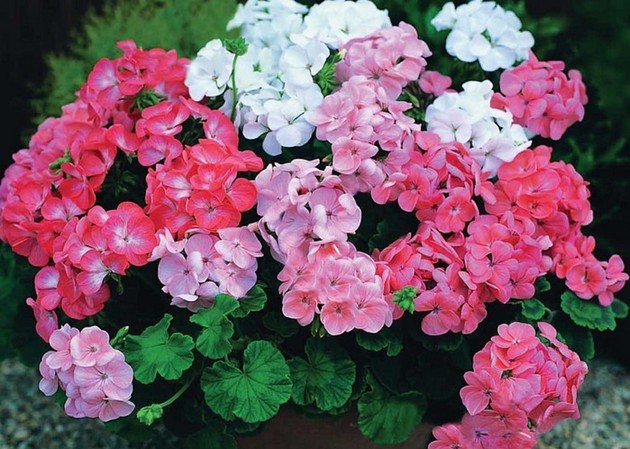

Breeders have developed geranium varieties with large flowers like roses white, red, pink flowers, there are varieties with multi-colored - two-, three-color flowers. Geranium is considered an amulet flower that preserves peace and happiness in the house where it grows, and varieties with large white flowers bring family well-being and healthy offspring.


In addition, due to the high content of essential oils and phytoncides in the plant, geranium heals the air of the room, interferes with the reproduction of pathogenic bacteria.
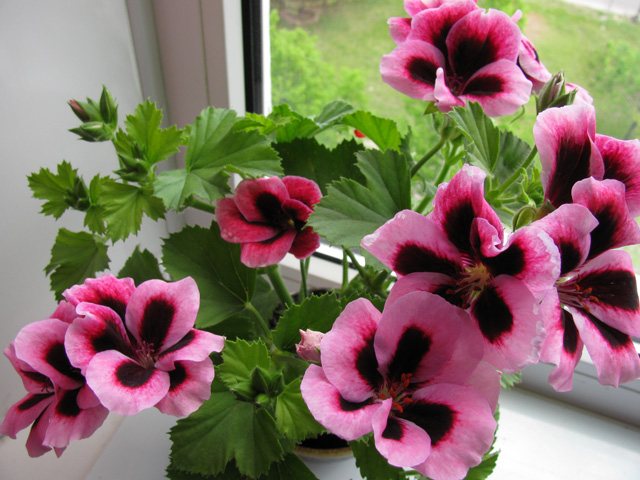

Caring for geraniums is simple: the plant does not like bright sun and too much watering, otherwise it is unpretentious. Geraniums are propagated by cuttings and sowing seeds, which are sown in light soil and periodically fed seedlings during the growth process.
Balsam
Terry balsam (impatience or touch-me-not) is a popular plant due to its exceptional unpretentiousness, which can be found on the windowsills of apartments and offices, and in the summertime - in flower beds and flower beds.
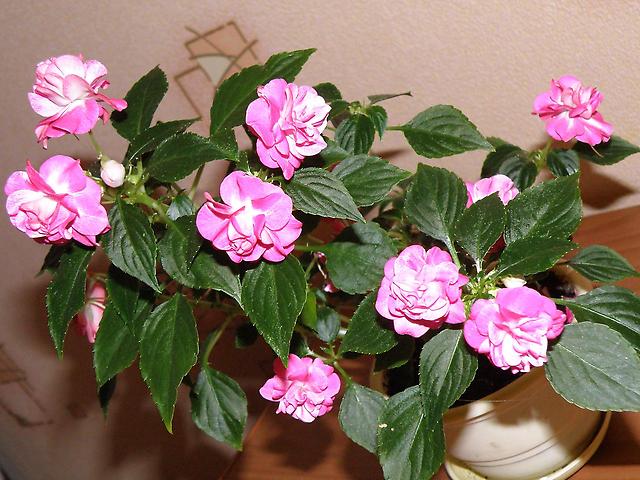

Balsam blooms in small flowers, similar to tea rose flowers - white, pink, cream, scarlet, burgundy colors, there are also varieties with two-color flowers, while the trunk and leaves can be either the usual green or deep burgundy.
Balsam loves light, loose soil, moderate frequency of watering, tolerates temporary drought quite persistently, but sheds leaves and buds at the same time. He loves spraying and requires careful handling: balsam stalks are fragile and break easily. It propagates very easily - by cuttings and sowing seeds. This is the most fragile and home of all flowers similar to roses.
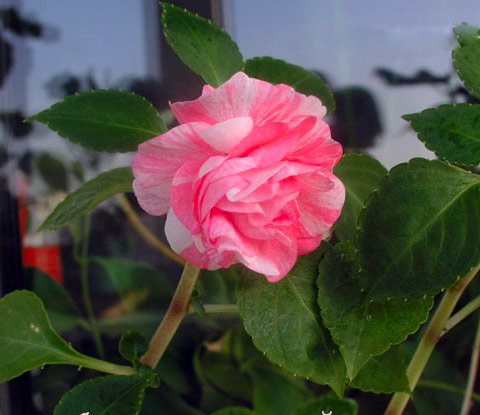

Gardenia
Gardenia - flower, highly rose-like, just as majestic, and practically as moody. Contrary to popular belief, the plant is named not from the English word garden, but from the consonant (“speaking”) surname of the American botanist Gardena.
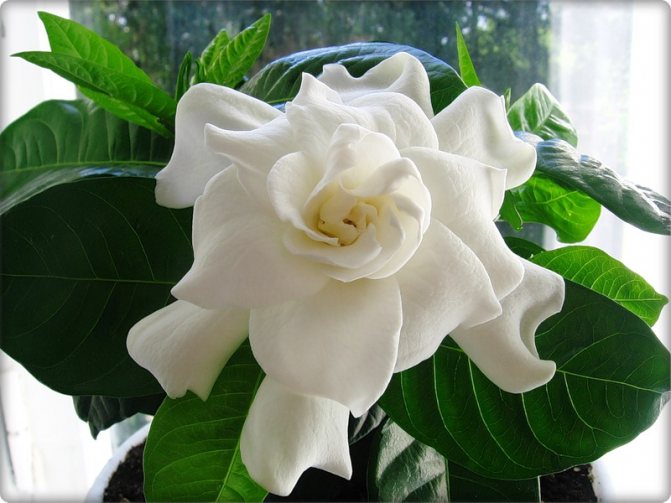

It differs from the rose in its aroma - it is close to the clear and ringing scent of jasmine, therefore there is also the name “gardenia jasmine”.
There are several subspecies of gardenia with tall, medium-sized and dwarf plants. Gardenia flowers are snow-white, later becoming light cream.
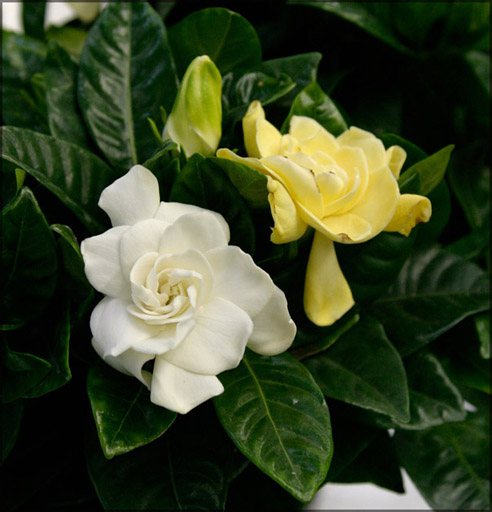

Today, in the wild, gardenias are only found in China and Japan, where they bloom from July to October. Gardenia cultivars prefer a room without direct sunlight, but light enough (if necessary, you can illuminate the plant with a lamp). Gardenia loves watering regularly, once a month - acidified water.
Desert Rose
Terry adenium (desert rose) - belongs to the genus of succulents, it is distinguished by bright - red, white, pink flowers with a variegated pattern on the petals.
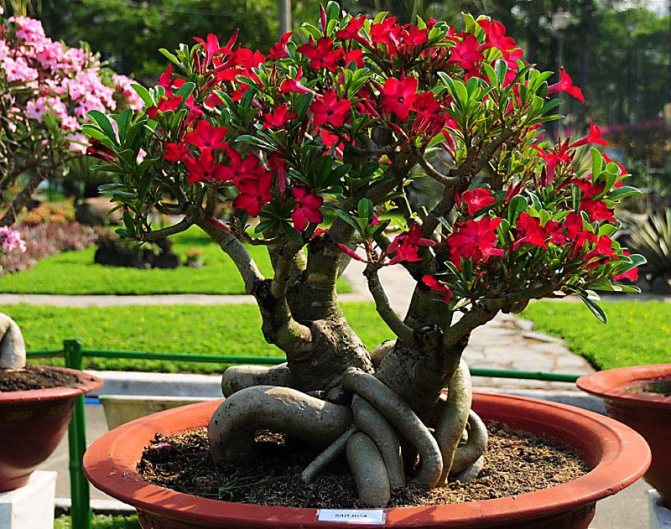

It blooms all summer and early autumn. In the wild - in southern Africa - adeniums can reach 10 meters in height, but cultivated varieties are much more modest - they usually grow to a maximum of 35-40 cm.
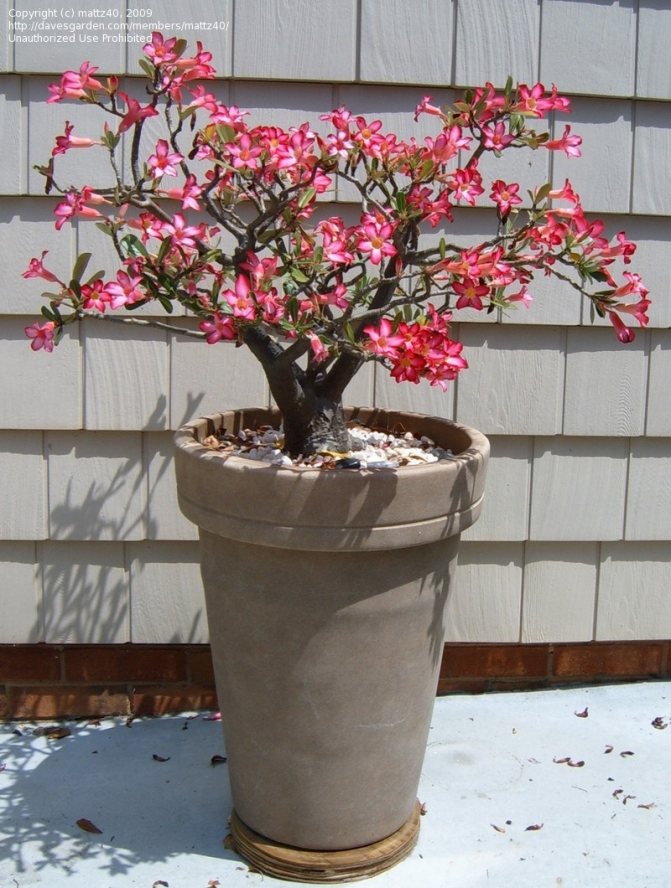

Adenium owners need to remember that the sap of the plant is poisonous, and if there are children or pets in the house, they should not have direct access to the flower.
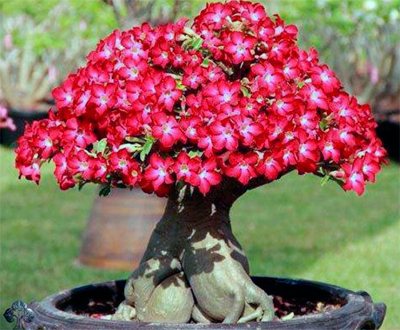

The plant tolerates drought well due to the moisture reserve in the stems and fleshy leaves.In spring, summer and early autumn, adenium is more comfortable outside, it should spend the winter indoors.


This is undoubtedly the most exotic of them all. flowers similar to roses.
Perennial primroses
Terry primroses (primulae) - perennial hybrid varieties of primroses with large terry flowers very similar to roses.
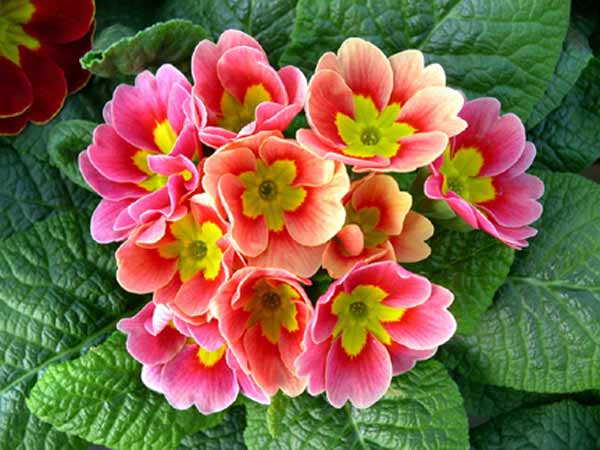

These plants feel equally comfortable both indoors and outdoors, they are unpretentious, propagated by seeds or by dividing the bush.
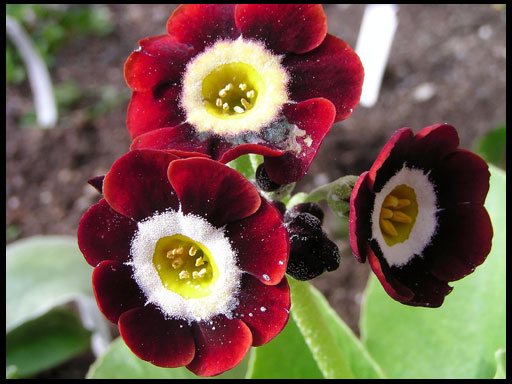

In a slightly shaded place, in a nutritious light soil, perennial primrose can bloom for up to 4 months, and what is especially important - such flowering begins as soon as the snow melts: primrose refers to primroses that begin to decorate flower beds and flower beds before anyone else, while other plants are still are in hibernation.
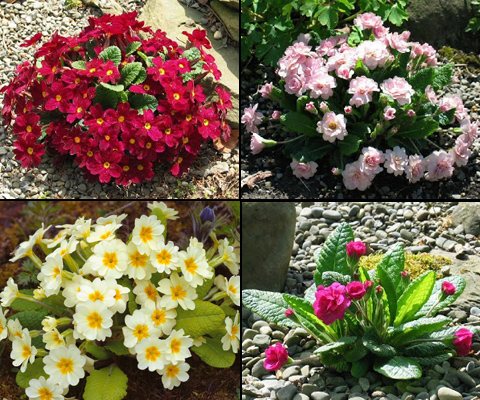

Conclusion
Of course, it is difficult to compete with the noble rose queen. But there are many flowers no less attractive than her, with their own unique qualities, worthy of taking a place in a flower garden, rockery, on a veranda or a windowsill. Cultivating street and home flowers like roses, you can exquisitely diversify your botanical collection and learn a lot about the flora of the globe and the traditions of floriculture in different countries of the world.
The author of the text is Lana Chaika.
Tips from experienced summer residents
Having been cultivating plants for a long time, flower growers have gained some experience, which they share with beginners. Here are some tips from them:
- If the flowers are grown as cut flowers, then the side branches and buds are removed so that all power and nutrition go to the main shoot.
- To get earlier growth and flowering, seeds are sown, and cuttings are rooted in late February or early March indoors.
- The distance between the bushes should be large enough. With frequent planting, ventilation is difficult, and this threatens the appearance of fungal diseases.
This is interesting: Peonies: planting, care, how to do pruning correctly
Flowers that look like peonies can be planted in a flowerbed or mixborder together, you can monochrome, another option is to combine with other plants that are unlike them. Be that as it may, they will always be a bright decoration of the garden.
Asian buttercup, or ranunculus
This is a beautiful Turkish flower, which is completely unsuitable for the Russian cold weather, therefore, it is better to remove the option with planting in the garden right away. There are no special recommendations for care. The height of a fully ripe flower is up to 30 centimeters, several buds are formed on it, their shades are quite varied: yellow, red, pink, white. They look very interesting, because the size of the buds for this height is rather big - 5-7 cm. Somehow the ranunculus resembles both a rose and a peony, such a peculiar hybrid. What care features will have to be observed for high-quality cultivation:
- in appearance, the tubers are similar to "crow's feet", as for their number, then at least four "claws", this is for ordinary cultivation in small quantities;
- before planting the first tuber, it must be held in a warm cloth and put in a warm place;
- if you plan to plant in open ground, you need to do it around May, so that the flower begins to form by summer;
- feeding is required, but once every two weeks, not more often. For good fertilization, nitrogen is needed in a small amount, and after the seedlings have formed, fertilizers should also contain phosphorus and potassium.
Terry primroses. Hybrid varieties
An adorable primrose can also compete with a rose in attraction. New species, hybrid varieties allow you to plant a flower on a garden plot or on a windowsill that will delight you for a long time. These plants include perennials - stemless terry primroses that easily take root in a new place and are unpretentious in care. You can grow from seeds, prudently sowing them in the ground in autumn or early spring.A plant grown from seeds will be able to fully please the owners with its flowering only after a year. Therefore, you should be patient, which will definitely be rewarded.


It is difficult to compare in the duration of flowering with a terry primrose, because in some cases its duration is up to four months per season. However, this is possible only with rich, loose soil and the absence of direct sunlight. Under favorable conditions, a mature plant develops very well, double inflorescences reach 5 cm in diameter and are very similar to roses.
Of course, it is already honorable to compare with the queen of flower beds for the plants presented, but in addition to beauty, they all have a lot of advantages that gardeners celebrate and increasingly choose them as favorites on their plots and window sills.
Conditions for planting and caring for eustoma
It is better to grow this plant by sowing seeds. Choose a light and neutral acid soil. With increased acidity, seedlings will grow very slowly. It is better to take peat soil with the addition of sand. Peat tablets are a good alternative.
In order for the seedlings to germinate together, cover the container with seeds with a film, since they love heat (temperature at least 25 degrees) and moisture. As soon as the seeds germinate, remove the film and add backlighting, especially in winter, otherwise the sprouts will weaken and stretch out.
Water after the top layer has dried, avoiding moisture stagnation. To protect the grown seedlings from diseases, they are fed with fertilizers (zircon, foundationol). After about a month and a half, the grown seedlings dive and again cover with foil for a couple of days. At the same time, it is not recommended to abruptly remove it - the plant must be gradually hardened, opening the container, and only then open it completely. Transplantation to a permanent place in a pot is carried out after the formation of at least 4 leaves in the sprouts.
What are the flowers that look like peonies
Peonies are lush and beautiful flowers that can beautify a garden plot. But they require sufficient growing experience and a lot of time. Without observing the watering regime, regular feeding and timely transplantation, the bushes quickly lose their decorative appearance. Peony rose, ranunculus, and carnation are good substitutes for those looking for easy-care, peony-like flowers. These plants do not belong to a related species, but are similar in appearance.
In the article we will talk about the features of flowers that look like peonies: characteristics of the plant, the subtleties of growing and what it is suitable for.
Growing
Peonies can grow in one place for a long time. The place is chosen sunny. Peonies are not dug up for the winter, they easily tolerate frosts. They begin to bloom, as a rule, in the third year after planting. For this reason, they should not be repotted frequently.


Peonies - all about them
In this, peonies and peony roses are similar. They should also not be repotted frequently. Roses may bloom next year, but this should not be given to them: the buds are cut off so that all forces go into building the root system. The landing site should be well lit by the sun. For the winter, peonies and roses spud and hide.
Important! In order for the rose to grow strong lateral shoots that will bloom, the faded buds must be removed.
Bulbous peonies (daffodils, tulips) bloom as early as the next spring after planting. In summer, after flowering, the bulbs are dug up, and in the middle of autumn they are planted again. Since bulbs are the first to bloom, they are well lit by the sun wherever they are planted.
Asters are annuals. Their entire life cycle runs from early spring to frost. Then the flower dries up, seeds are collected from it for further reproduction. The next year they are sown, the life cycle begins anew. Astra is unpretentious to the composition of the soil, but the lighting should be bright. Otherwise, the stems will be thin, elongated.
Interesting: Chlorosis
Eustoma is a biennial. In the first year, it forms a rosette, blooms - another year later. For the winter, eustoma must be carefully mulched and covered. In colder regions, it is dug up, in the spring it is planted again in open ground. Propagated by seeds only. The soil for eustoma should be light, well-drained.
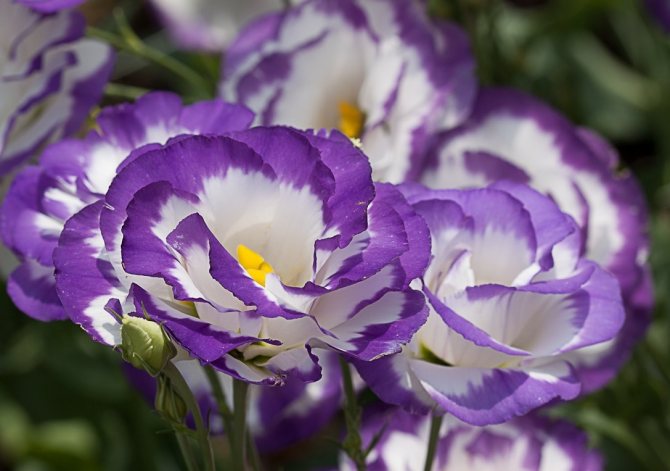

Chrysanthemums are perennials. They easily reproduce by shoots, cuttings. Bloom begins in the fall. For the winter, they must be spilled and covered. In a harsh climate, the roots are dug up and stored in a cool place until spring.
Note! In order for the chrysanthemum buds to grow large, the plants need to be pinned.
The Shabo carnation, which most of all looks like a peony, is also dug out for the winter, since it can freeze out from large frosts. Easily propagated by seeds, prefers to grow in a well-lit place.
Ranunculus is planted in a slightly shaded area in the spring, when the threat of frost has passed. In the fall, the root is dug up for storage from the cold. Ranunculus can be grown indoors. Several bushes in one pot will look more spectacular.
How to plant ranunculus
Garden ranunculus grows well in bright sun, but still prefers partial shade. The soil should be neutral in composition, light and fertile (loam will not work). The plant will need good drainage, so add some sand to the bottom of the hole. Do not forget to add compost and pickle the soil with a foundationol solution (1 g per 1 L of water).
Ranunculus seeds are sown on seedlings in mid-February, spreading them on the surface of light fertile soil and sprinkling with soil with a layer of 1-2 cm.Then the container is covered with foil or glass and placed in a well-lit place at a temperature of 15-17 ° C. 2-3 weeks after the emergence of seedlings, the shelter is removed, and after the appearance of two true leaves, the seedlings dive into separate pots and planted in the ground.
Before planting, the tubers are soaked in water for 3-4 hours
Ranunculus care tips:
- the plant needs regular, but moderate watering so that the roots do not suffer from excessive moisture, but also do not rot;
- remove faded inflorescences in time so that they do not interfere with the growth of new ones;
- periodically loosen the soil and apply potash fertilizers (40-50 g per 1 sq. m) once every two weeks during the flowering period;
- for the prevention of diseases, spray the plants with a 0.2% solution of mercaptophos 2-3 times a week;
- Dig up the flower tubers in the fall and store in sawdust in the winter - the plant does not tolerate cold weather and dies.
So, today we got acquainted with three peony-like flowers that are just as unpretentious to care for and almost do not need feeding. And which twin brothers of peonies do you plant on your site?
Herbaceous or herbal rose
What indoor flowers bring happiness and well-being to the house
The plant is called herbaceous rose because of the herbaceous shoot. At different stages of development, culture is like a rose, a poppy, a tulip. In the presence of terry varieties with snow-white, pink, bluish colors. The dimensions of the flower reach 8 cm, up to 20 pieces are formed on one culture.
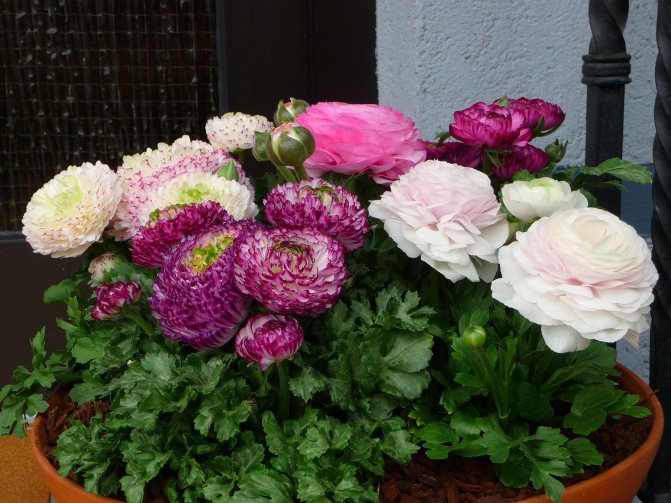

The result of feeding ranunculus
Their dissolution begins simultaneously. They do not fade for 14 days.
Habitat
Cryptobellis stemless (in Latin, Cryptobellis acaulis), or herbal rose, belongs to the Asteraceae, or Asteraceae family. Lives in the highlands of the island of Hawaii.
Plants brought in by humans have a different fate: some individuals in Hawaii lacked specific pollinators, others were non-competitive. However, some species turned out to be viable and feral. Cultures took an active part in the formation of the flora of the Hawaiian Islands.
Appearance
On the mountain slopes, with an abundance of sunshine, winds blow all year round and it is quite cool at night, an amazing culture grows there.It forms an elastic rosette of hairy green-silvery sheets with a diameter of 15 cm. The elongated root penetrates deep into rocky crevices.
A chamomile inflorescence is formed among the rosettes, which is surrounded by a number of lilac petals (reed flowers). They sit in the middle of the outlet among the leaves. Wide sheets have finely serrated edges.
For its appearance, the culture is called herbal rose. The meaning of the word cryptobellis is a hidden daisy. A light-loving perennial is content with a minimum of humus.
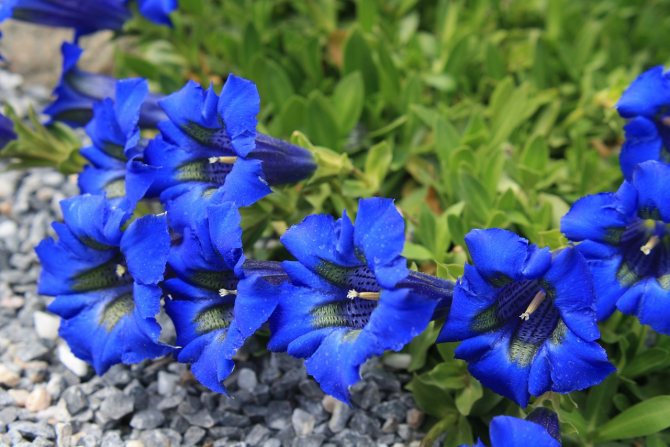

The attractiveness and charm of the plant
The leaves rise up at night and close the inflorescence, protecting it from the cold, and keep insect pollinators. Ripening of herbaceous rose seeds after pollination occurs a month later. The wind helps the reproduction of small achenes with hairs at the top.
Flowering period and lifespan
The flowering of young crops falls on the 3rd year of life, in cold regions - on the fifth. When Cryptobellis blooms and bears fruit, the rosette of the mother culture dies. By this time, lateral buds are formed at its base, from which new rosettes develop, and the flower does not die. Then the plant lives from 10 to 12 years.
The rose remains the queen of the flower bed, but all the listed plants that resemble it are beautiful and can take their well-deserved place in the country.
Additional Information. Excalibur is a novelty among shrub roses. The diameter of apricot flowers is 10 cm, the number of petals is 25 pcs. A tall branchy bush (up to 150 cm) blooms again. Flowers are admired from early summer to autumn, at small intervals.
Doubles will decorate the personal plot: a flower garden, a window, a terrace. Compliance with the peculiarities of cultivating luxurious flowers is appreciated. Cultures live and develop, they need love, care and proper care.


